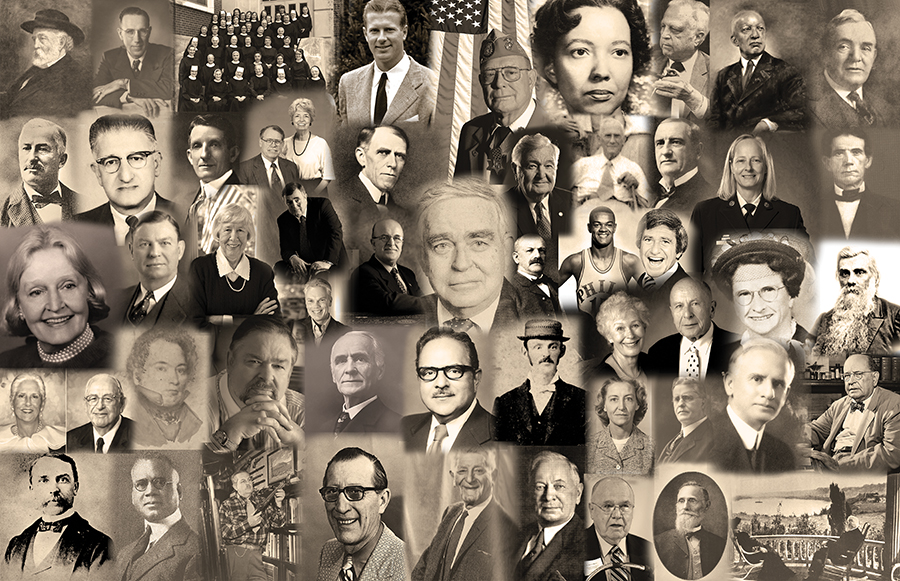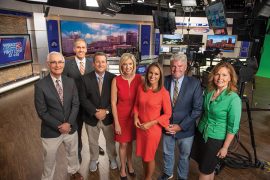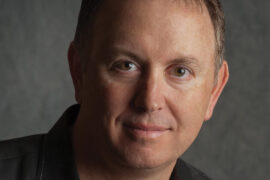Meet the esteemed citizens who helped transform a cornfield on the banks of the Ohio River into the beautiful community it is today.
By James E. Casto & Jack Houvouras
HQ 121 | Spring 2023
In 1869, after playing a pivotal role in building America’s transcontinental railroad, industrialist Collis P. Huntington was restless. He set out to build a new railroad connecting Richmond, Virginia, to the Ohio River Valley. He eventually found his way to a humble stretch of farmland on the banks of the Ohio River in West Virginia, and there decided to locate the western terminus of his recently acquired Chesapeake & Ohio Railway. It would also become the city that bears his name. On Feb. 27, 1871, the West Virginia Legislature approved an act incorporating the City of Huntington.
In the 152 years since that historic day, a number of esteemed citizens have played critical roles in the city’s growth and development. Many of these men and women helped guide this region through good times and bad, disaster and recovery. When Huntington was ravaged by floods in 1913 and 1937, the citizens persevered and eventually erected a 7.37-mile floodwall to protect the city. On Nov. 14, 1970, when the plane carrying the Marshall University football team and numerous prominent Huntington residents crashed on its approach to Huntington’s Tri-State Airport, killing everyone onboard, some suggested ending the football program. Instead, the city and university decided to rebuild once again, thus honoring the 75 souls lost on that tragic night. That, in essence, is the spirit found in the people of Huntington. Nowhere is that spirit more evident than in the following 50 individuals who called Huntington home.
Our process for compiling this list included research using several books on local history; interviewing local authors and historians; and rating each individual based on their career success, contributions to the community and pride in their hometown. They are listed in as close as possible to chronological order.
Collis P. Huntington

Collis Potter Huntington (1821-1900) never lived in Huntington, but without him the city wouldn’t exist. Born in Connecticut, he left school at age 14 and became a Yankee peddler. When gold was discovered in California in 1848, Huntington went west and became a rich man by selling supplies to the miners. He and his partners built the Central Pacific, the western half of the long-dreamed-of transcontinental railroad. It was successfully linked with the rival Union Pacific by the driving of a golden spike at Promontory, Utah, on May 10, 1869. The same year, Huntington purchased the Chesapeake & Ohio Railway and set about extending its tracks across southern West Virginia to the Ohio River. There, in 1871, on the site of a large cornfield overlooking the river, he established the city that bears his name.
The Holderby Family

James Holderby (1782-1855) owned much of the land that today comprises Huntington. On his death, he divided his property between his two sons, William and Edward. William inherited a vast tract of farmland overlooking the Ohio River. Included was a river wharf that carried the family name — Holderby’s Landing. There he built a mansion that burned in the 1930s. Edward was given an equally large tract of land immediately south of his brother’s holdings, stretching to today’s Washington Boulevard. In 1880, he built his own mansion on a hillside overlooking what would become today’s Hal Greer Boulevard. After Edward died in 1890, his widow and three daughters continued to live in the 15-room mansion. When Mrs. Holderby died in 1930, heirs sold the old house to the county, which used it as the Cabell County Detention Home for youthful offenders. The old house was demolished in 1954.
John Laidley
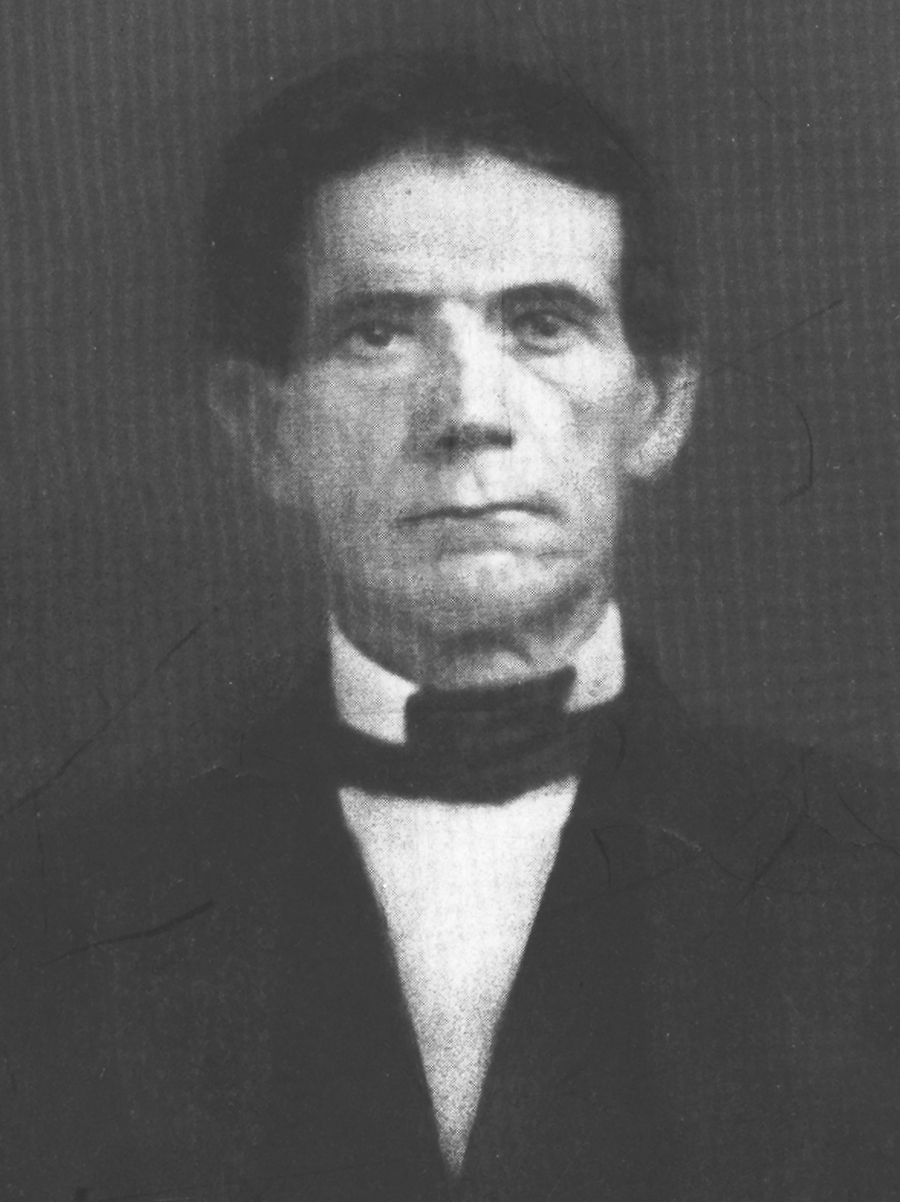
A number of Guyandotte citizens played roles in the founding of Marshall Academy. Chief among them was attorney John Laidley (1791-1863). Laidley was a friend and admirer of Chief Justice John Marshall, with whom he had served in the Virginia Constitutional Convention of 1829-1830, and it was at Laidley’s behest that the new school was named for the famed jurist. Born in Morgantown, John Laidley read law with his brother James in Parkersburg and served in the War of 1812. After the war, he made his home in Guyandotte, where he practiced law until his death. In 1937, Marshall named Laidley Hall, a dormitory, in his honor.
Peter Cline Buffington

Peter Cline Buffington (1814-1875) was a surveyor, a merchant, a bridge builder and a quartermaster in the Cabell County unit of the Virginia Militia. He represented Cabell County in the Virginia General Assembly, was the first trustee of Marshall College (now University) and was the first president of the Bank of Huntington. In 1871, when the first election was conducted in rail tycoon Collis P. Huntington’s new town, Buffington was elected its first mayor. He served in the post for two years and died the following year.
Delos W. Emmons

Collis P. Huntington’s business dealings required that he spend months at a time in California, New York, Washington, D.C., and other far-flung locales. This meant he needed somebody he could leave in charge of his namesake city. He found that man in his brother-in-law, Delos W. Emmons (1829-1905), who had married Huntington’s sister Mary. The couple moved to Huntington, where in 1871 Emmons oversaw the first sale of lots in the new town. This photo shows Emmons and Mary enjoying the river view from the porch of their Huntington home. Three of their children played important roles in Huntington’s growth. Carlton D. Emmons was one of the founders of Emmons-Hawkins Hardware Co. J. Allen “Ollie” Emmons ran a furniture factory. Arthur S. Emmons became Huntington’s first city clerk and in 1910 built the Emmons Apartments. In 1924, a second apartment, the Emmons Jr., was built next door. Both buildings were demolished in 2007 after a tragic fire that claimed nine lives.
Bradley W. Foster

Bradley W. Foster (1834-1922) married Mary Lenora Huntington, a niece of Collis P. Huntington, in 1868; and three years later, the couple moved to Huntington. On arriving, Foster built one of the city’s first hardware stores. The venture ultimately evolved into the Foster-Thornburg Hardware Company, a major wholesale firm. Foster and Mary had no children. On Foster’s death, he left $800,000 to build and operate a home for older unmarried women and widows. Over the years, the Foster Memorial Home sheltered thousands of local women. But times change. And beginning in the 1980s, the Foster Foundation’s board began talking about the growing need for adequate housing for all seniors, not just women. The result was construction of the Woodlands, a beautiful, sprawling retirement community overlooking Fifth Street Road.
Sam Gideon

German-born Sam Gideon (1836-1923) was one of Huntington’s earliest merchants and most prominent citizens. Immigrating to this country, he fought on the Union side in the Civil War. After the war, he settled in Cincinnati. He and his wife Dora arrived in the new city of Huntington in 1872 and opened a clothing store at 949 Third Ave. The store was a busy part of the city’s retail scene for more than 50 years. Meanwhile, Gideon also became active in politics, serving on the Huntington Board of Education for nearly 25 years and on the Cabell County Court.
John Henry Cammack

John Henry Cammack (1843-1920) was born on a farm near Dayton, Virginia. In 1859, his family moved to Harrison County in what is now West Virginia. Entering the Confederate Army at age 17, he returned to Harrison County and the family farm after the war. He later moved to Williamstown in Wood County, where he started a cigar factory. Urged by his doctor to give up cigars and find a healthier pursuit, he moved to Huntington, entering the insurance business. He helped establish the city’s Fifth Avenue Baptist Church and later the Twentieth Street Baptist Church. The former Cammack Middle School and Cammack Elementary were named in his honor.
W.H.H. Holswade
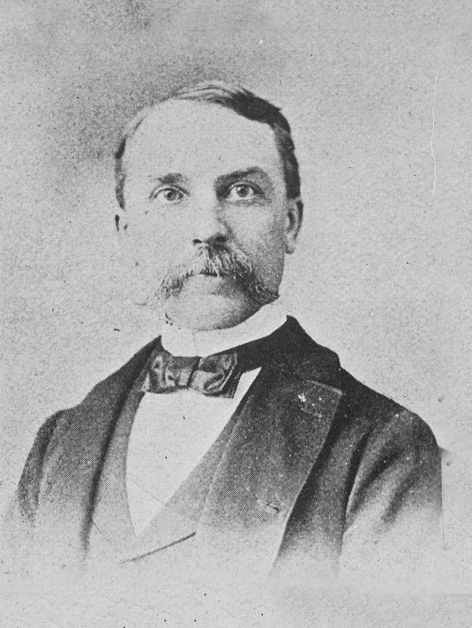
William Henry Harrison Holswade (1845-1908) first worked as a postal clerk, then tried his hand at running a cigar stand and a bookstore before going into the furniture business. His store on the south side of Third Avenue between Ninth and 10th streets specialized in furniture made in its own shop. Holswade was a Mason, an Odd Fellow, president of the Huntington Chamber of Commerce and a member of the school board. Like most furniture dealers of his era, Holswade also acted as an undertaker. In those days it wasn’t unusual to find coffins for sale side by side with rockers and kitchen tables. On Holswade’s death, his son J.F. Holswade continued to operate the furniture store until 1915, when he sold the property to the S.S. Kresge Co., which opened a 5-and-10-cent store.
J.L. Caldwell
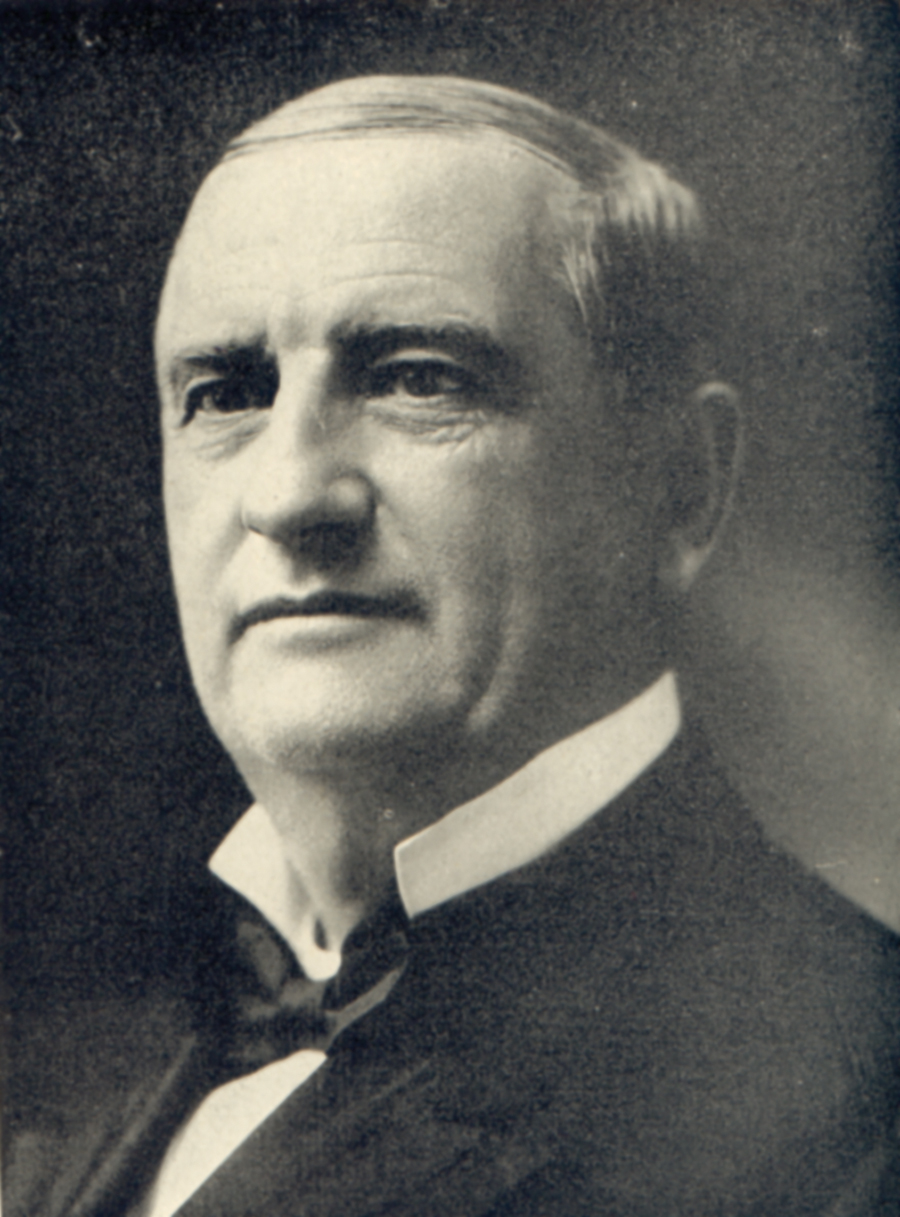
James Lewis Caldwell (1846-1923) was one of the first to see the possibilities of the rich coalfields of southern West Virginia and built the Guyandotte Valley Railway to tap that natural wealth. He was born in Elizabeth in Wirt County, fought in the Union Army and after the war traveled the state selling insurance. When Collis P. Huntington founded his new town, Caldwell moved to Huntington and quickly took advantage of the opportunities it presented, investing in a number of business ventures, including the city’s first streetcar line. In 1884, he and his partners organized the First National Bank of Huntington with Caldwell as president, a post he held until his death nearly 40 years later. In 1914, the bank built a 12-story building at Fourth Avenue and 10th Street, known today as the St. James Building, that is still a downtown landmark.
Ely Ensign

Connecticut businessman Ely Ensign (1850-1902) came to Huntington and established the Ensign Manufacturing Co. in 1872. Initially the company’s plant produced only railroad wheels, but in 1881 it began building wooden rail cars and soon became one of the largest car building facilities in the United States. In 1899, Ensign Manufacturing was one of 13 rail car companies that were consolidated into the American Car and Foundry Company (ACF). After the ACF consolidation, Ensign remained as general manager of the Huntington plant until his death.
Frank B. Enslow
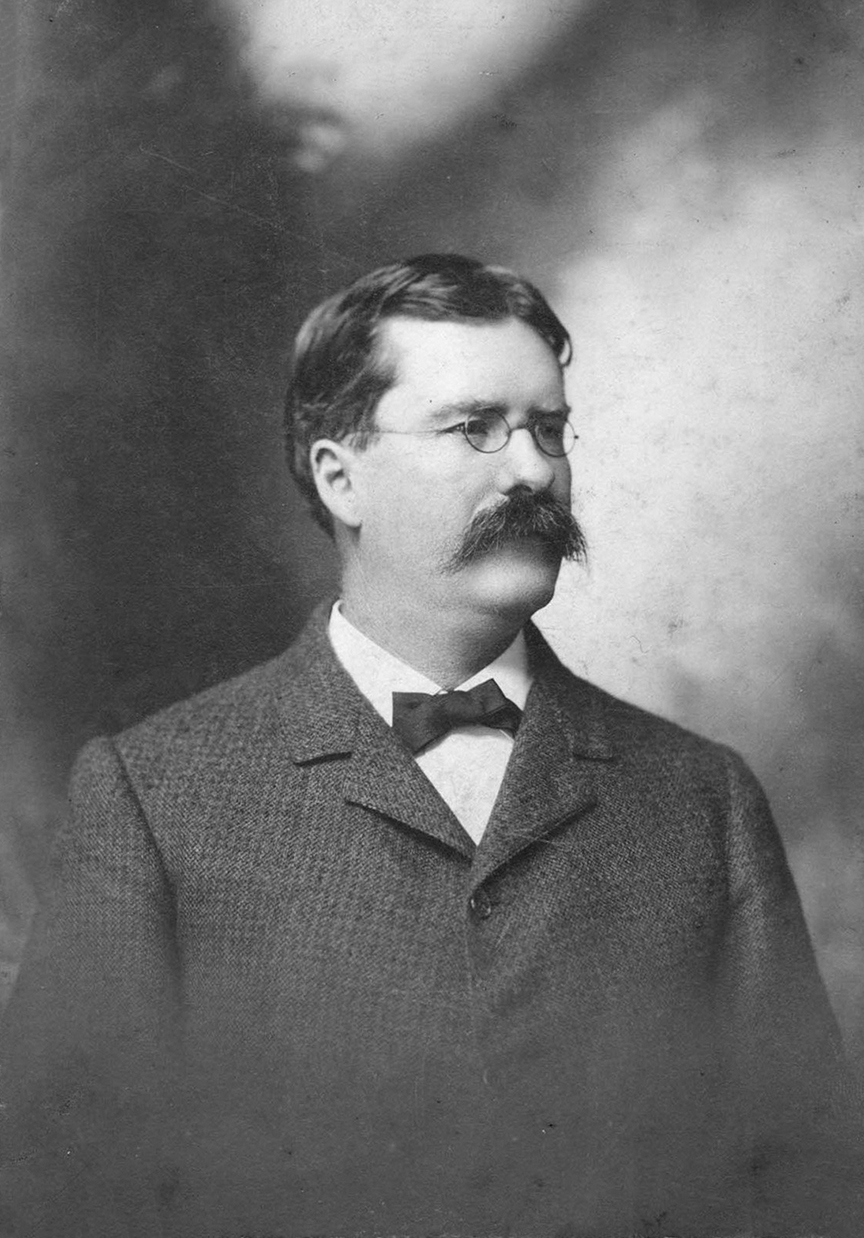
The name Enslow has been a familiar one in Huntington since 1871, when railroad contractor Andrew Jackson Enslow arrived to help build the Chesapeake & Ohio Railway. His son, Frank Bliss Enslow (1853-1917), grew up in Huntington and entered the practice of law with Henry C. Simms. In addition to his law practice, Enslow had extensive business interests in banking, oil and gas and other fields. Local legend credits him with being the city’s first millionaire. Certainly his opulent 26-room mansion at 1128 Third Ave., with its marble fireplaces, Tiffany chandeliers and stained-glass windows, was a local showplace. Built in the 1890s, the Enslow mansion was a center of Huntington social life in that long-ago era. Decades later, the elegant mansion would also be the scene of one of Huntington’s most famous mysteries when, on the morning of Oct. 17, 1936, the millionaire businessman’s widow, Juliette Buffington Enslow, was found dead — beaten, stabbed and strangled — in her second-floor bedroom. Her murder was never solved. The mansion later housed the Steele Funeral Home for a number of years before it burned.
Rufus Switzer
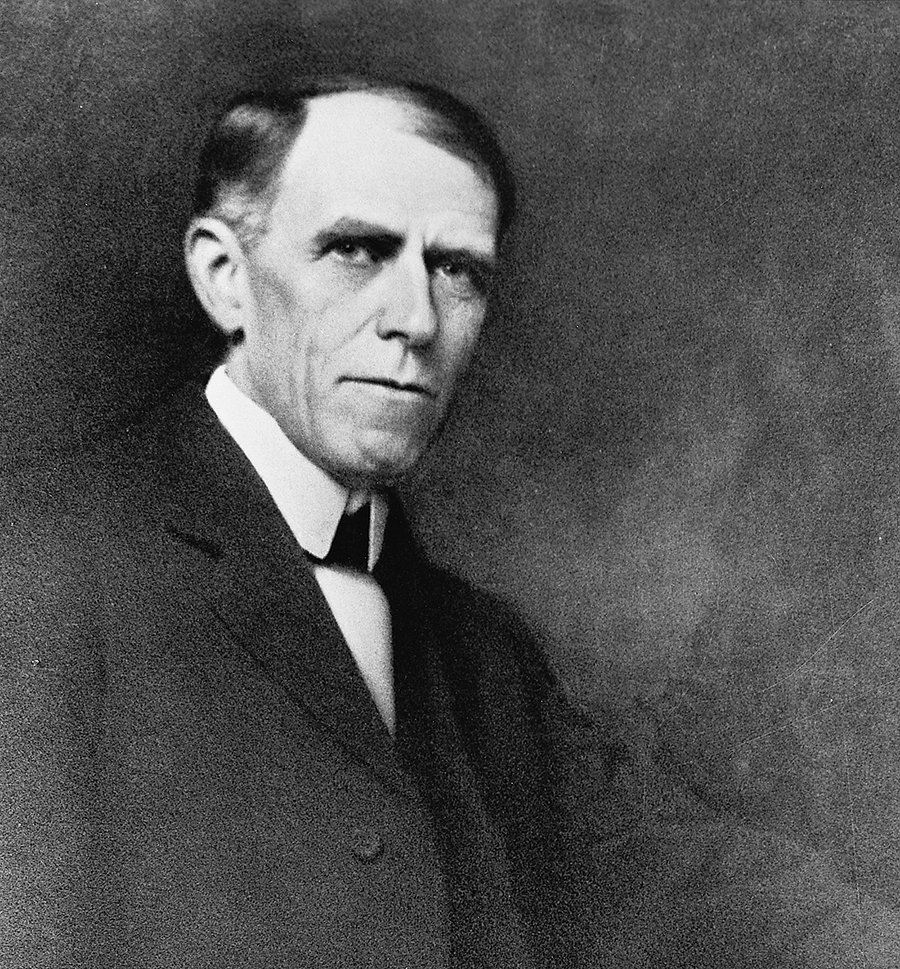
Huntington’s plans for his new city made no provision for a public park. Several park proposals were offered in the city’s early years, but none came to fruition until lawyer Rufus Switzer (1855-1947) was elected mayor in 1909. The city had purchased a tract along Four Pole Creek as the site for an incinerator. Not surprisingly, neighbors objected, and a donnybrook ensued. As mayor, Switzer settled the matter by declaring that the purchased property would become a park. Thus, one of the city’s most popular landmarks, Ritter Park, was born. It was also under Mayor Switzer that Guyandotte and Central City were annexed into Huntington. In his will, Switzer established a perpetual trust and directed that two-thirds be used “for the use and maintenance of an art gallery, historical museum and cultural center.” In the Huntington Museum of Art’s formative years, Switzer’s generous bequest was the lifeblood of the institution. Switzer directed that the remaining one-third of the trust be used “for the study, research and treatment of human disease.” As such, The Huntington Clinical Foundation Inc. was organized. A handsome park, a thriving museum, a healthier community — that’s an impressive legacy, perhaps unequalled in the city’s history.
D.E. Abbott

When young Darwin Eugene Abbott (1856-1942) was hired to help a family move from Vermont to Huntington, he decided to stay and cast his fortune with the new city. He attended Marshall Academy (now University), then became interested in photography. He toured West Virginia, taking pictures for Harper’s Magazine. In 1880, Abbott opened a successful photographic studio in Huntington on the 900 block of Fourth Avenue. In 1898, Abbott purchased a glass plant at Washington Avenue and W. 14th Street. He incorporated D. E. Abbott & Co. and added the manufacture of picture frames and moldings to his business. His firm proved to be one of the young city’s most important manufacturing enterprises. His work was sold throughout the United States and even exported to Europe.
Z.T. Vinson
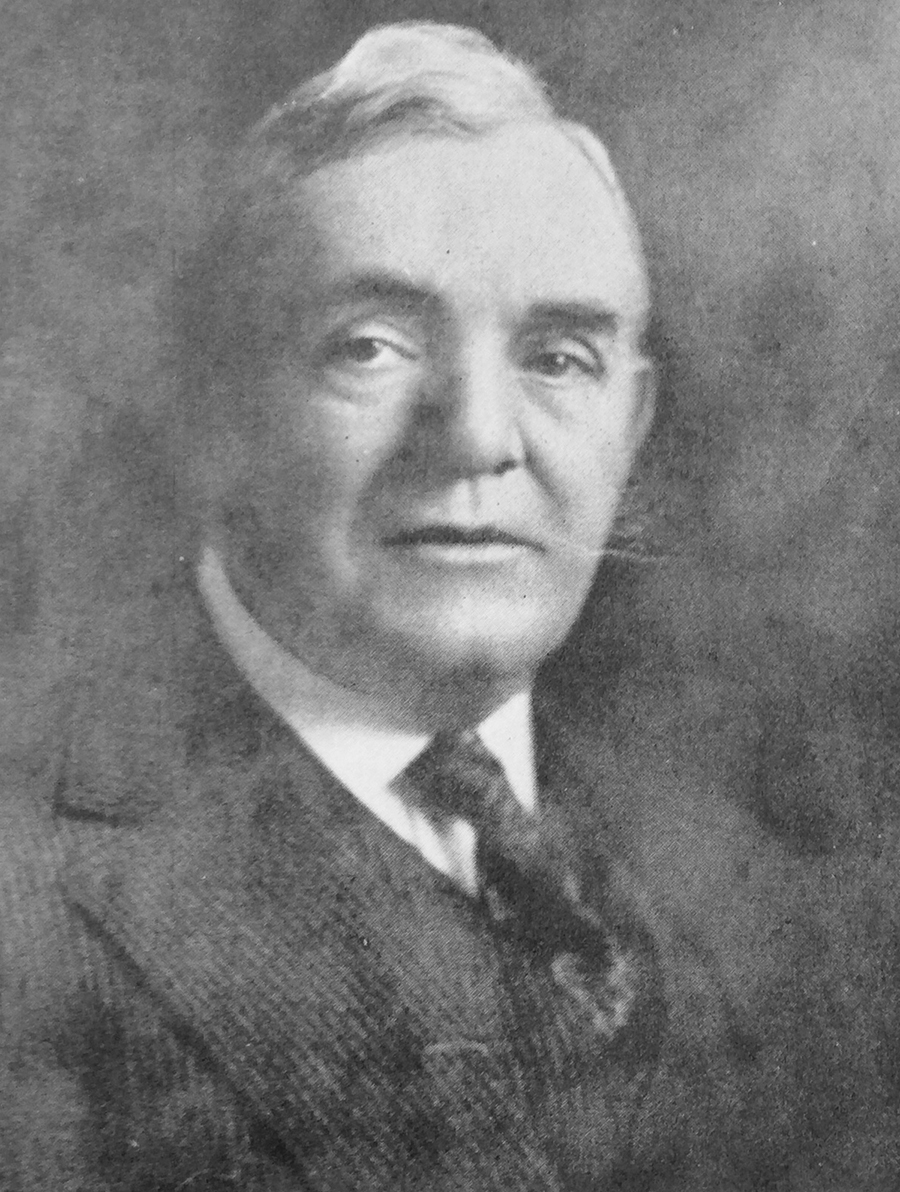
Zachary Taylor Vinson (1857-1929) was born in Wayne County and educated at Bethany (West Virginia) College, the Law School of the University of Virginia and Boston University Law School. He first practiced law in Ceredo, West Virginia, and then moved to Huntington where he was a director and general counsel for the United States Coal and Oil Company and attorney for the Ohio Valley Electric Railway Co. He was one of the founders of Huntington’s Central Christian Church and taught a Sunday School class there. On his death the class was named the Vinson Memorial Bible Class. Westmoreland’s Vinson Junior High and later Vinson High School were named for one of Wayne County’s most prominent families.
J.H. Long

Pennsylvania-born Joseph Harvey Long (1863-1958) learned the printing trade in Wheeling. Moving to Huntington in 1893, he purchased The Advertiser, a small daily paper that signified the first building block in what would become a local media empire. For a number of years, Long’s afternoon Advertiser slugged it out with the morning Herald-Dispatch, owned by Dave Gideon. In 1925, the two newspapers declared a truce and merged as the Huntington Publishing Co., with Long as chairman and Gideon as president. The mechanical and business operations were combined while the two news staffs operated independently. Recognizing the potential of television, Long established the state’s first TV station, WSAZ, which signed on for the first time in 1949.
Charles Lloyd Ritter

Lumberman Charles Lloyd Ritter (1865-1945) was born in Pennsylvania. In 1889, he came to West Virginia and entered the lumber business at Oakvale in Mercer County. Two years later he moved to Welch, where he organized the Tug River Lumber Co. Its offices later moved to Bluefield and then to Bristol, Virginia, before Ritter brought the company to Huntington in 1901. Ritter settled permanently in Huntington, purchasing many important commercial properties in the downtown business district and investing in lumber, coal, gas and mineral developments in West Virginia and nearby states. He built an impressive mansion atop Eighth Street Hill, south of the city, which later became a convent for the nuns working at St. Mary’s Hospital. In 1908, the city bought 55 acres of land along Four Pole Creek, proposing to build an incinerator there. Not surprisingly, Ritter didn’t welcome the idea of an incinerator just downhill from his estate. So he offered to donate 17 additional acres to the city if all the land was designated as a park. The city not only took him up on his offer but proceeded to name the park in his honor. That marked the beginning of Huntington’s park system.
Dr. C.C. Barnett
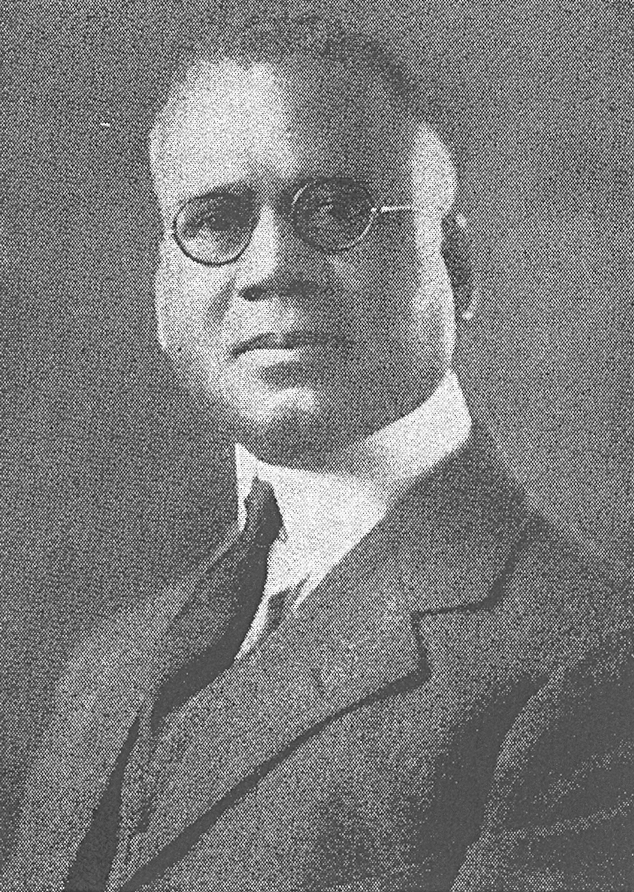
Dr. Constantine C. Barnett (1869-1935) was born in New Canton, Virginia, the son of slave parents. The family moved to Huntington in 1871. Educated in the local schools, Barnett earned his medical degree at Howard University. Returning to Huntington, he began practicing as a physician and surgeon in the city’s African American community. Although his work as a doctor was already a huge accomplishment, Barnett wanted to give more back to the African American residents of Huntington. Inspired by the story of a young Black employee of the Chesapeake & Ohio Railway who was injured on the job and eventually died because he was refused treatment due to his skin color, Barnett opened the Barnett Hospital in his home. When it first opened, the little hospital had only a few beds. But it was greatly added to over the years and eventually had 50 beds, 10 physicians, eight nurses, two operating rooms and an X-ray department. In 1918, Dr. Barnett’s wife Clara, a trained nurse, opened the Barnett Nursing School. At that time, few of the nation’s nursing schools would admit African Americans. Unable to pay the mortgage, Dr. Barnett lost his hospital to the bank in the Great Depression, but for another decade the city operated it, treating patients of all races. It closed for good in 1939.
Fred C. Prichard
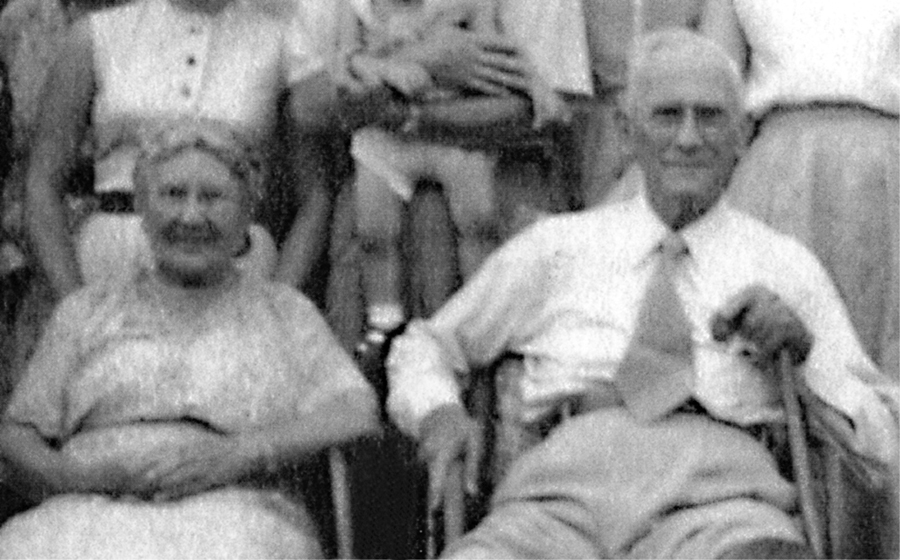
When he died on Dec. 2, 1960, at age 89, Fred C. Prichard (1871-1960) was described by a local newspaper as “one of the builders of Huntington.” Having acquired most of his wealth from coal, he constructed two of the city’s skyscrapers — the Hotel Prichard and the Robson-Prichard Building, known more recently as the Chaffin Building. Because he and his wife could not have children, Prichard decided to devote much of his wealth to the cause of helping needy and orphaned children. In the mid-1920s he purchased 650 acres of land near Ona and built an architecturally stunning home and school for disadvantaged children. Named The Prichard School, it not only provided the basic necessities of life, but also a good education. Teachers were employed, and initially 25 orphaned boys and girls were taken in. Prichard and his wife adopted the first seven children, who were given the Prichard name.
Herbert Fitzpatrick

A Huntington lawyer who rose to become head of the Chesapeake & Ohio Railway, Herbert Fitzpatrick (1872-1962) is remembered today for the key role he played in establishing the Huntington Galleries — now the Huntington Museum of Art. A Virginia native, Fitzpatrick joined the C&O in 1895 as local counsel in Huntington. In 1923, he was made vice president and general counsel. He was C&O board chairman from 1937 to 1940. Fitzpatrick donated the land upon which the museum was built, along with his substantial collection of paintings, prints, English silver and Islamic prayer rugs, which became the nucleus of the museum’s collection.
Dr. Carter G. Woodson
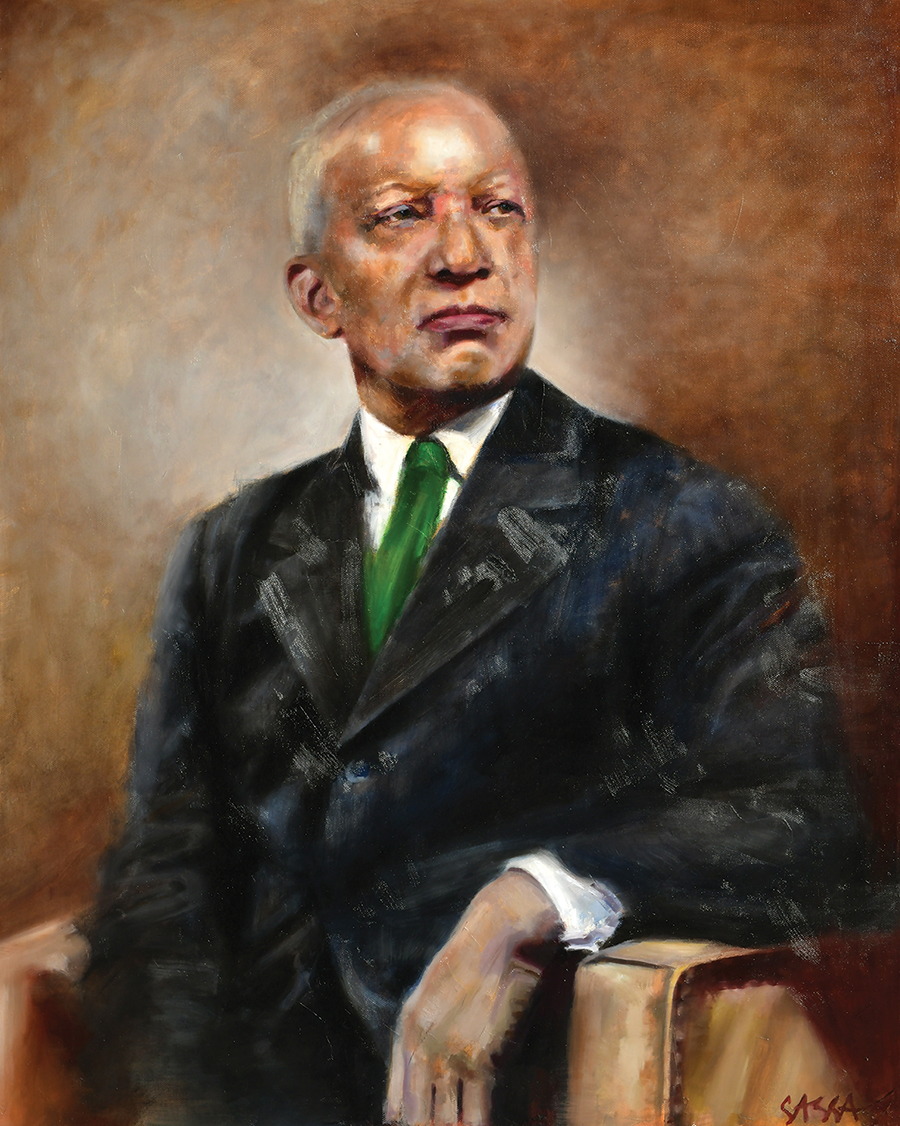
Dr. Carter G. Woodson (1875-1950), today universally acknowledged as the “Father of Black History” and the founder of Black History Month, was 19 years old when he moved to Huntington in 1895. He enrolled at the all-Black Douglass High School and graduated a year later. In 1900, he became principal of the school. He would go on to earn both his bachelor’s and master’s degrees from the University of Chicago before becoming only the second African American to earn a Ph.D. from Harvard University. He rose to international prominence as a noted educator and scholar and authored more than 12 books on Black history in America. In 1926, Woodson set out to publicly recognize the contributions of Black Americans to U.S. and world history. He selected February as the time for an annual celebration. What Woodson began as “Negro History Week” is now celebrated as “Black History Month.” Since his death, more than 30 schools, libraries and parks across America have been named in his honor.
Dr. Henry D. Hatfield

Dr. Henry D. Hatfield (1875-1962) was born on Mate Creek, near Matewan, West Virginia. A nephew of Anderson “Devil Anse” Hatfield of the famed Hatfield-McCoy feud, he earned a medical degree at the University of Louisville and returned to West Virginia as a coal-camp doctor in McDowell County. He was elected to the McDowell County Court in 1906 and to the West Virginia Senate two years later. In 1912, Hatfield was elected governor. When he took office the state was embroiled in a prolonged and violent coal strike. As governor, Hatfield was able to broker an uneasy truce between the striking miners and the coal operators. After his term as governor, he practiced medicine in Huntington for the next 40 years, interrupted by a 1928-1934 term in the U.S. Senate, during which he secured a veterans hospital for Huntington.
Stella Fuller
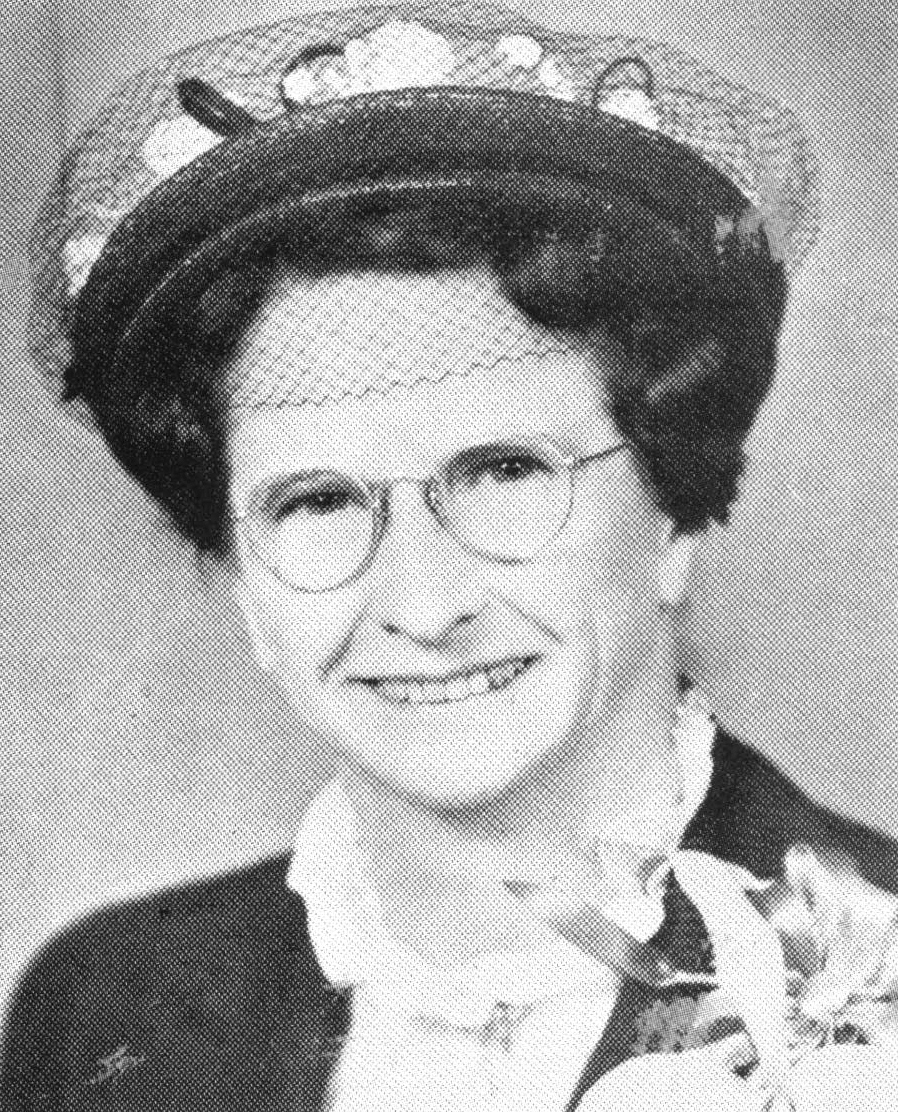
Stella Fuller (1883-1981) ministered to the needy of Huntington for more than 60 years, first as a member of the Salvation Army, then as head of her own settlement house. Born Stella Lewis Cremeans in Point Pleasant, she grew up in rural Mason County. At age 19 she moved to Huntington, where she attended business school. After graduation she moved to Welch to work for a law firm. She returned to Huntington after marrying Elmer Fuller in 1907. Attracted by the Salvation Army’s religious and charitable programs, she joined the organization in 1916, embarking on a career that would span more than 25 years. But she grew unhappy with the Salvation Army’s many rules and regulations and determined to do what she thought was best. And that’s exactly what she did for the next 38 years at the Stella Fuller Settlement, located at 128 Washington Ave. in one of Huntington’s poorest neighborhoods. She was known to many throughout the city as the “Angel of Huntington.”
Walter Lewis Sr.
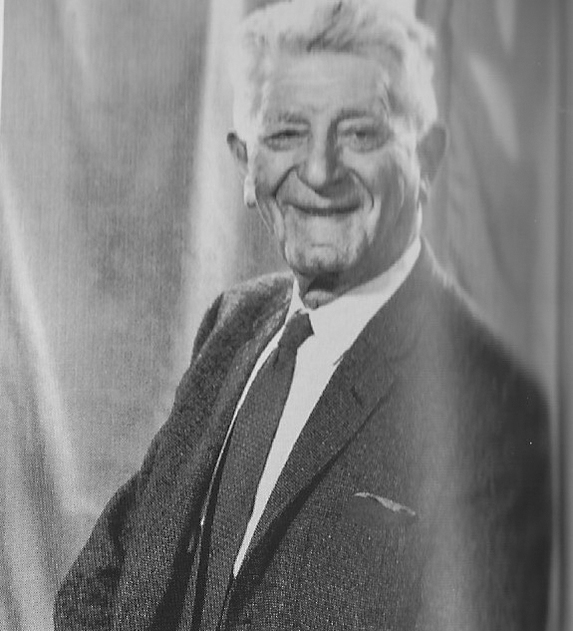
Walter Lewis Sr. (1885-1970) was born in Lithuania, came to the United States as a child and lived for several years in Texas before moving to Huntington in 1908. On his arrival in Huntington, he established a furniture store that grew into a chain of stores in West Virginia, Ohio and Kentucky. He was also active as a real estate developer. The City Parking Port, the Belford Village condominiums and the former Lewis Arcade were just three of his many projects. Long active in civic and philanthropic affairs, he was one of the founders of Ohev Sholom Temple.
Cam Henderson
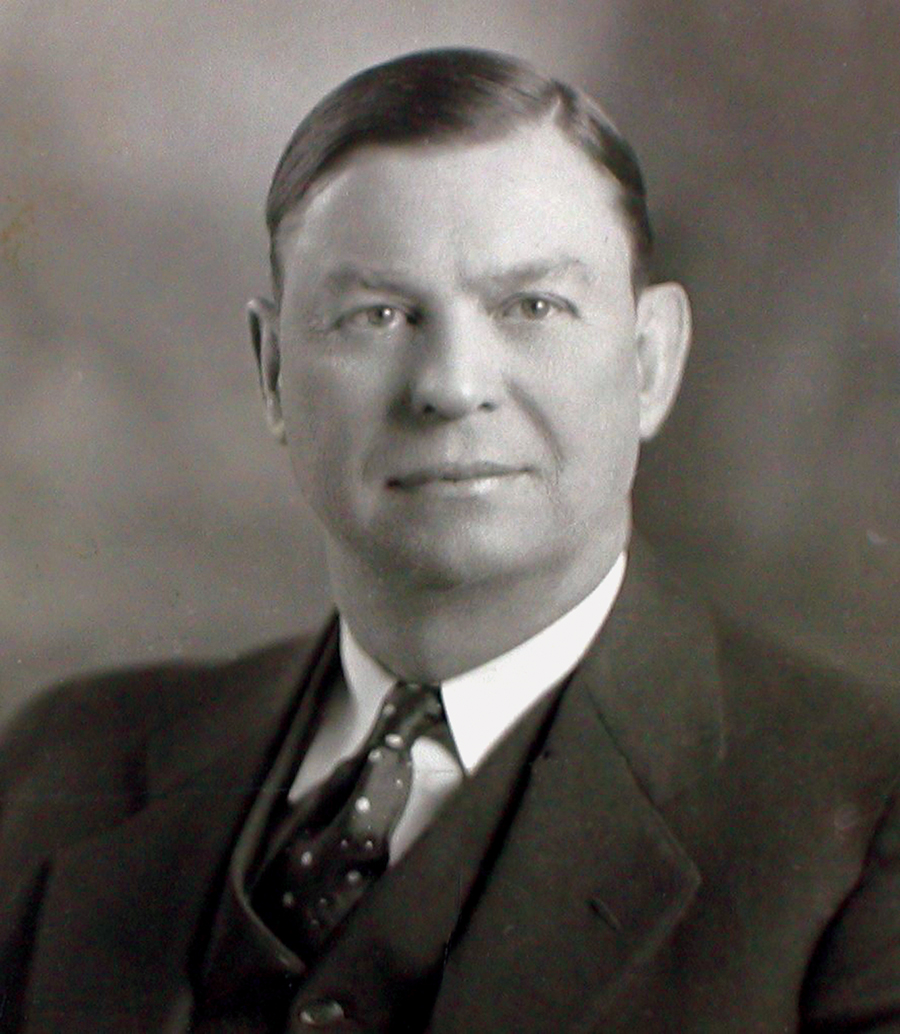
Legendary coach Cam Henderson (1890-1956) spent 20 years at Marshall University as both the football and basketball coach. He is best remembered for his contributions to the game of basketball, where he is credited with inventing both the zone defense and the fast break. In 1947 he led Marshall to its only national championship in basketball, capturing the NAIB (today’s NAIA) Basketball Tournament in Kansas City, Missouri. In 1981, in recognition of Henderson’s many contributions to both Marshall and Huntington, the university named its new 10,400-seat basketball arena in his honor. Today fans jam the Cam Henderson Center to cheer on the Thundering Herd. Many Huntingtonians think Henderson should be inducted into the Naismith Memorial Basketball Hall of Fame.
Sterling Diddle

Huntington businessman Sterling Diddle (1896-1980) was chairman of the board and founder of both the Guaranty National Bank of Huntington and Huntington Steel and Supply Co. He and his father, James A. Diddle, founded Huntington Boiler and Supply in 1904. The name was later changed to Huntington Steel and Supply. He founded the Guaranty Bank and Trust Co. in 1939. The bank became the Guaranty National Bank in 1954. Regarded by his peers as a brilliant businessman, Diddle was active in numerous civic affairs throughout his life. He was a founding member of the Marshall University Foundation. In 1999, grandson Sterling Hall and several other family members donated funds to build a fountain at the entrance of Ritter Park, which they dedicated to Sterling Diddle.
Herman P. Dean
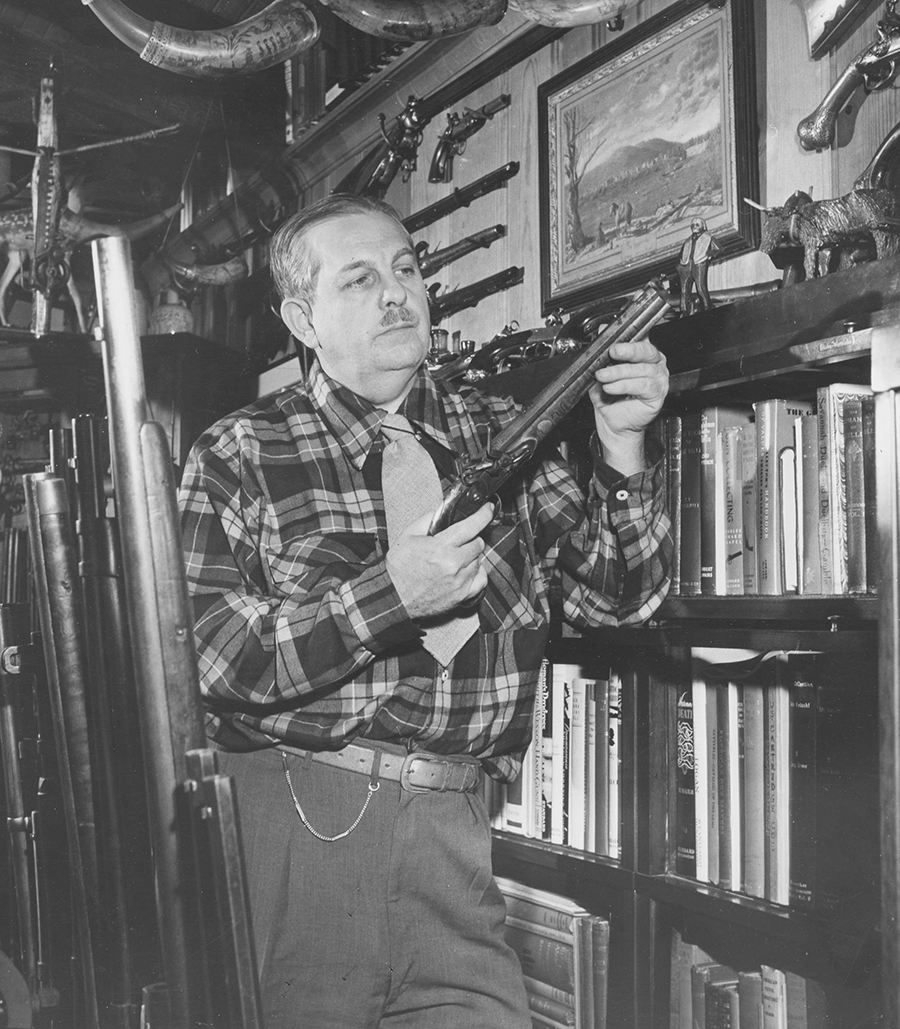
Herman P. Dean (1897-1978) packed several lifetimes of experiences into his busy eight decades. A businessman, he owned Huntington’s former Standard Printing and Publishing Co. A newspaperman, he published the weekly Wayne County News. A church and civic leader, he taught Sunday School at Huntington’s Central Christian Church for 30 years and aided a long list of charitable endeavors. A world traveler, he visited not just familiar tourist spots but such remote regions as the Canadian Yukon, where he even lived with the Eskimos for two years. He loved hunting, fishing and collecting antique guns. He spent a lifetime amassing his collection of firearms and then presented it to the Huntington Museum of Art.
Max Jones
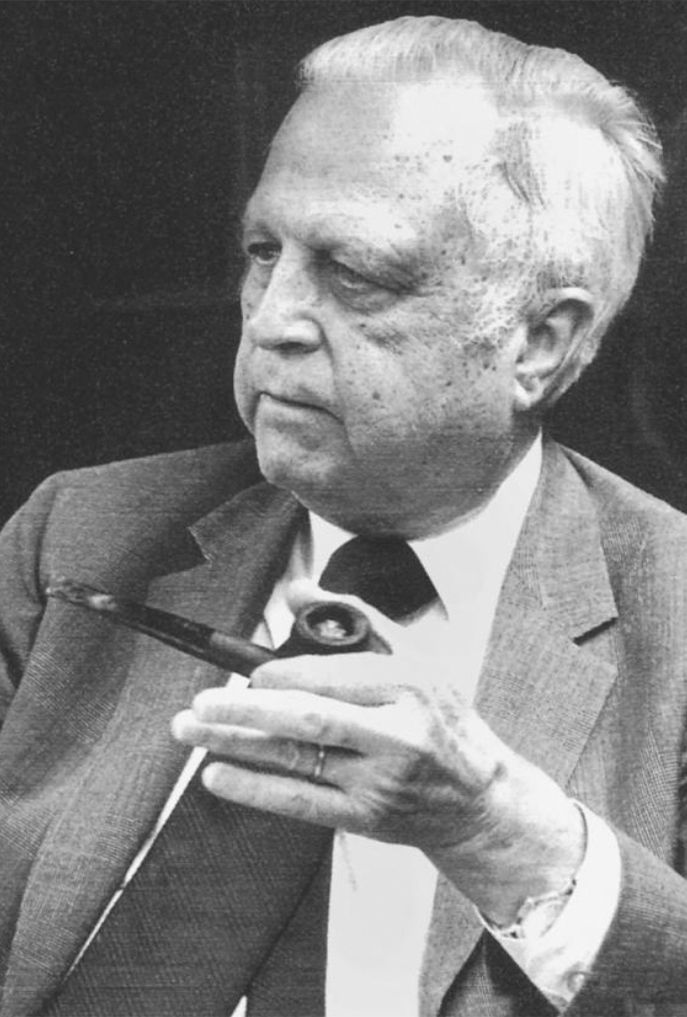
Max Jones, who died in 1980 at age 78, was manager of the old Huntington Water Company (now part of West Virginia American Water) and one of the city’s best-known business and civic leaders. As chairman of the Cabell County Recreation Board, he played a major role in the construction of the Veterans Memorial Field House. And as chairman of the Cabell County Hospital Board, he was a key figure in the creation of Cabell Huntington Hospital and helped foster its growth in its earliest years.
Michael R. Prestera
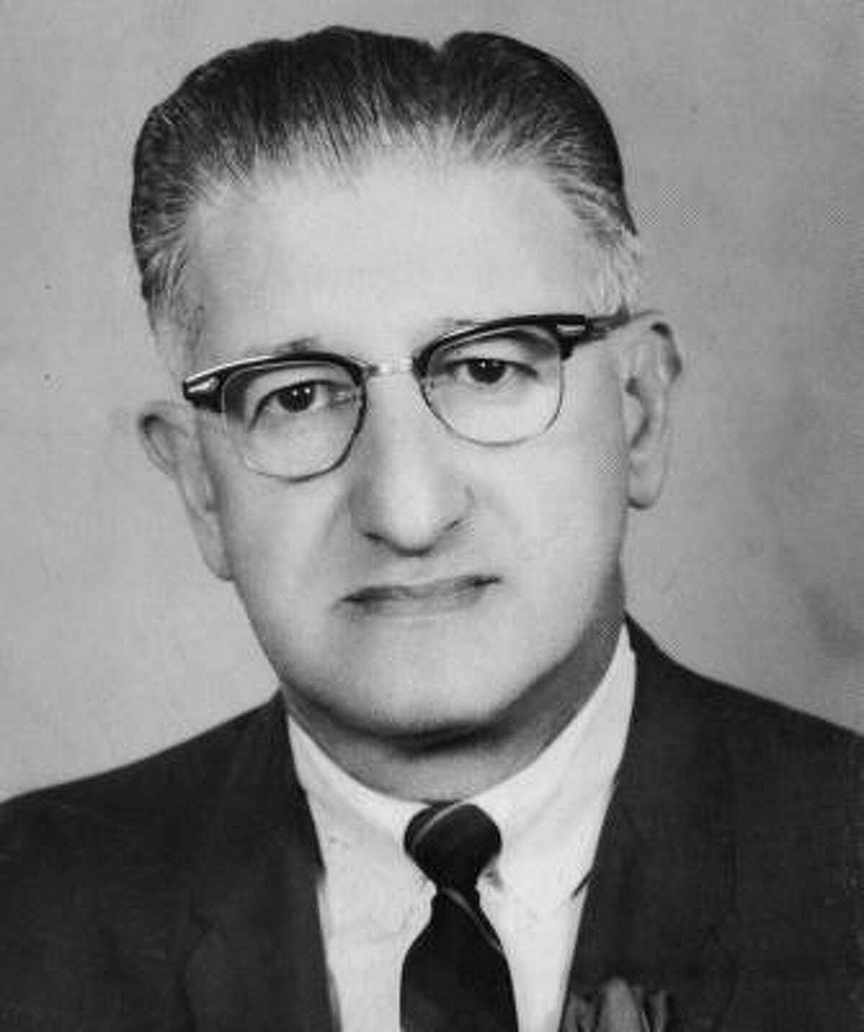
Michael Raymond Prestera was one of the victims onboard the chartered jetliner that crashed at Tri-State Airport on Nov. 14, 1970, killing all 75 Marshall football players, coaches, fans and crew members. He left a wife, Nancy; a daughter, Mary Anne; and three sons, Gene, Michael and Robert.
Born in 1909, Prestera was a successful businessman as the president of Whitten Transfer Company and the Prestera Trucking Company. He served as chairman of the KYOVA Interstate Planning Commission, president of the Big Green athletic boosters and founding president of the Southwestern Mental Health Center. In 1981, the center was renamed the Prestera Center for Mental Health Services to honor Prestera’s dedication. At the time of his death, he was a delegate-elect to the West Virginia Legislature.
The Sisters of St. Mary’s Hospital
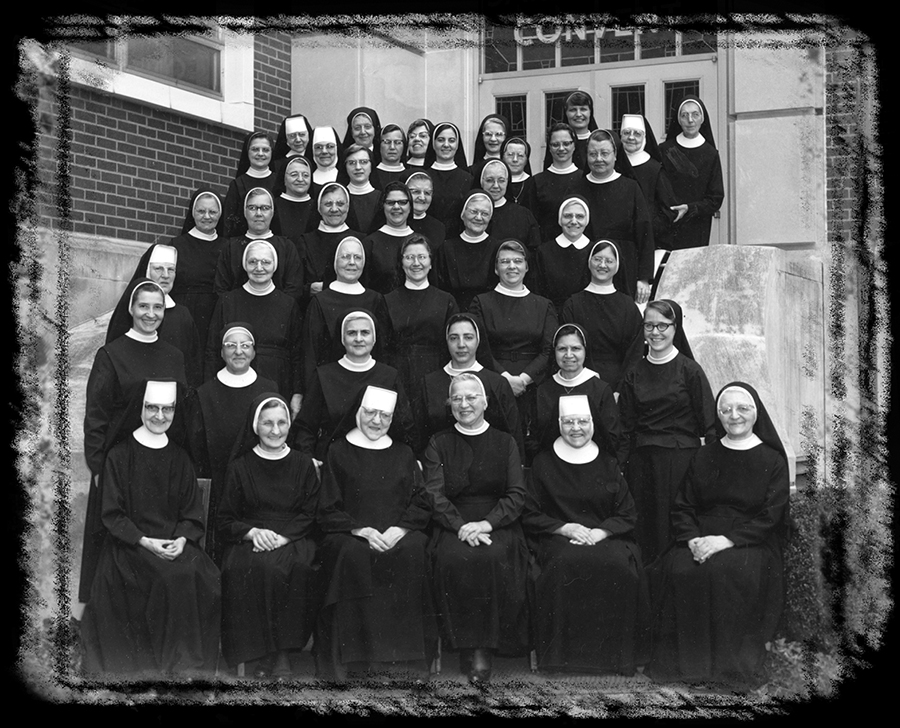
In 1912, a tiny band of Pallottine Missionary Sisters left their home in Bremerhaven, Germany, bound for America. They barely missed sailing on the ill-fated Titanic, fortunately booking passage on a later ship. Arriving in this country, they went first to Stella Niagara, New York, where they learned English, then came to West Virginia, where they opened hospitals in Richwood and Buckhannon. In 1924, the Sisters came to Huntington and opened a 35-bed hospital. In the hospital’s earliest years, the Sisters did all the work. They nursed the sick and injured, cooked, served, washed, ironed, cleaned, fired the clunky coal furnace and even grew their own fruits and vegetables. Today, the tiny hospital they founded has evolved into St. Mary’s Medical Center, the largest medical facility in Huntington, one of Cabell County’s largest private employers and, at 393 beds, one of the largest health care facilities in West Virginia.
Dr. Albert C. Esposito
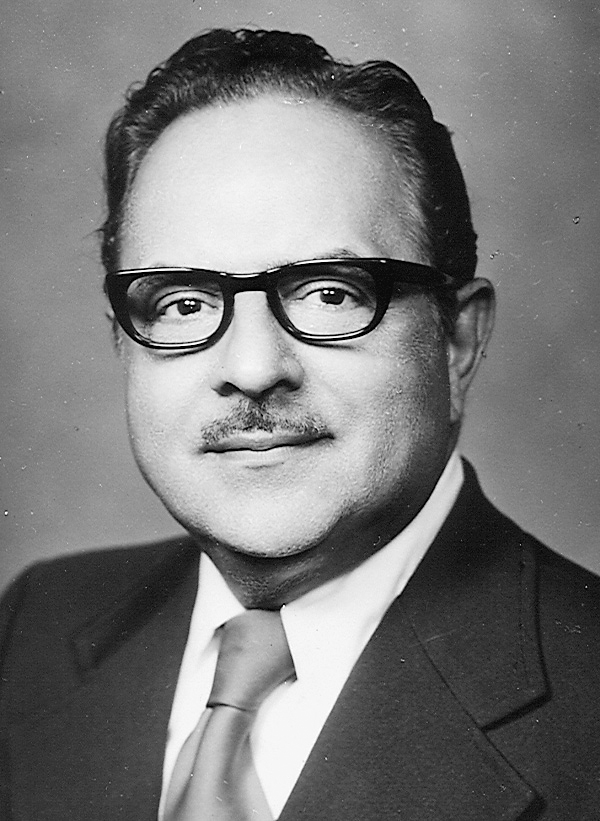
An ophthalmologist, Dr. Albert C. Esposito (1912-1995) practiced in Huntington for 48 years, from 1946 until he retired in 1994. Today, he is widely looked on as the “Father of the Marshall School of Medicine.” He served two terms in the West Virginia House of Delegates, where he repeatedly voiced his support for a medical school at Marshall. When Dr. Robert B. Hayes became Marshall president in 1974, he and Dr. Esposito worked hand in hand to make that dream a reality.
Harold Frankel
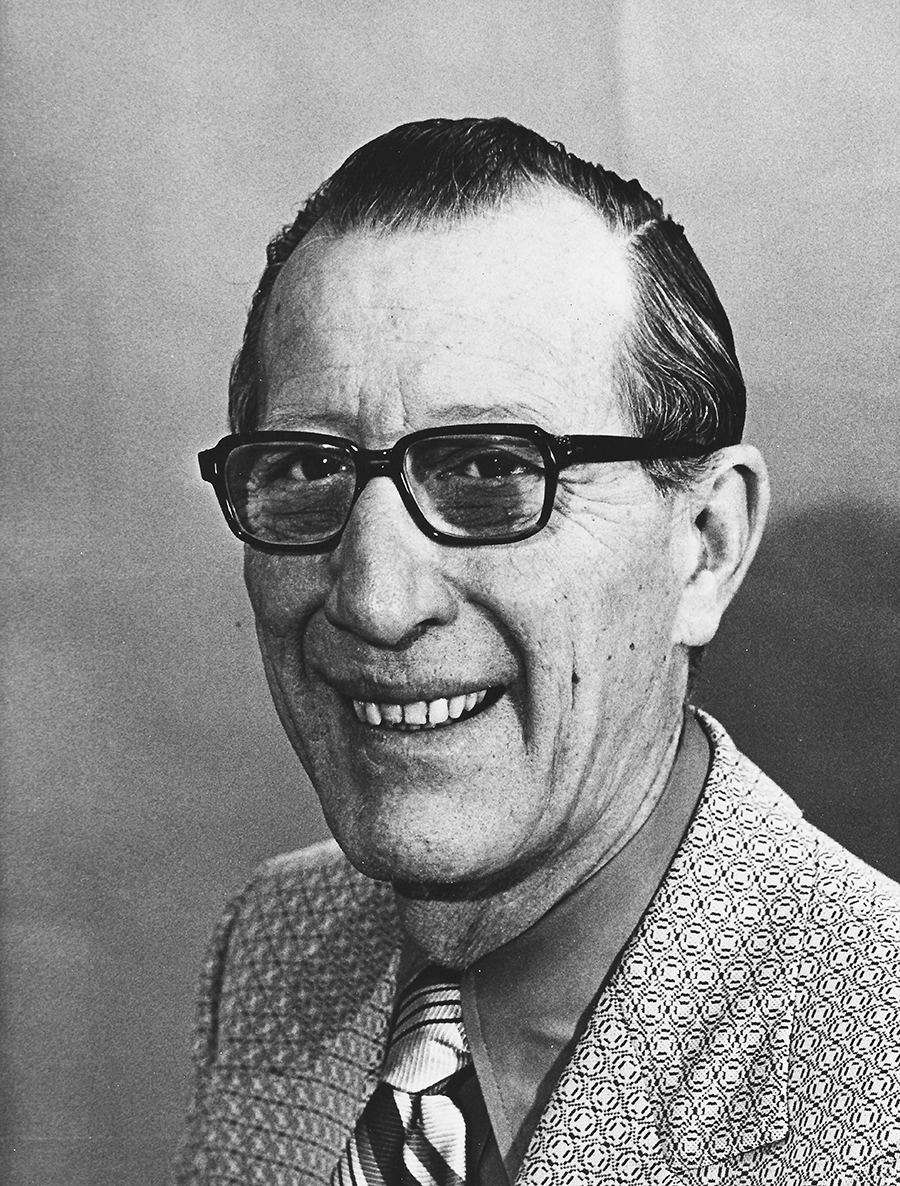
Even though Harold Frankel (1916-2002) spent the last 20 years of his life in Florida, Huntington has never forgotten his trademark grin and the seemingly boundless energy, enthusiasm and optimism he threw into everything he did. And those who knew him best say he never forgot Huntington. Frankel is remembered for his accomplishments in both business and politics. In business, he took over operation of his father’s clothing store, branched out into the appliance business, established a highly successful Holiday Inn on U.S. 60 East and then invested everything he had — and everything he could borrow — in construction of a new downtown hotel, the first built in the city in decades. Over the years its name has changed from Holiday Inn to Radisson Hotel to Pullman Plaza to, most recently, the Doubletree by Hilton Huntington. In politics, Frankel was a member of the Huntington City Council for a remarkable 16 years, served four one-year terms as mayor under the city’s former council-manager form of government and was Cabell County sheriff for four years.
James & Joan Edwards
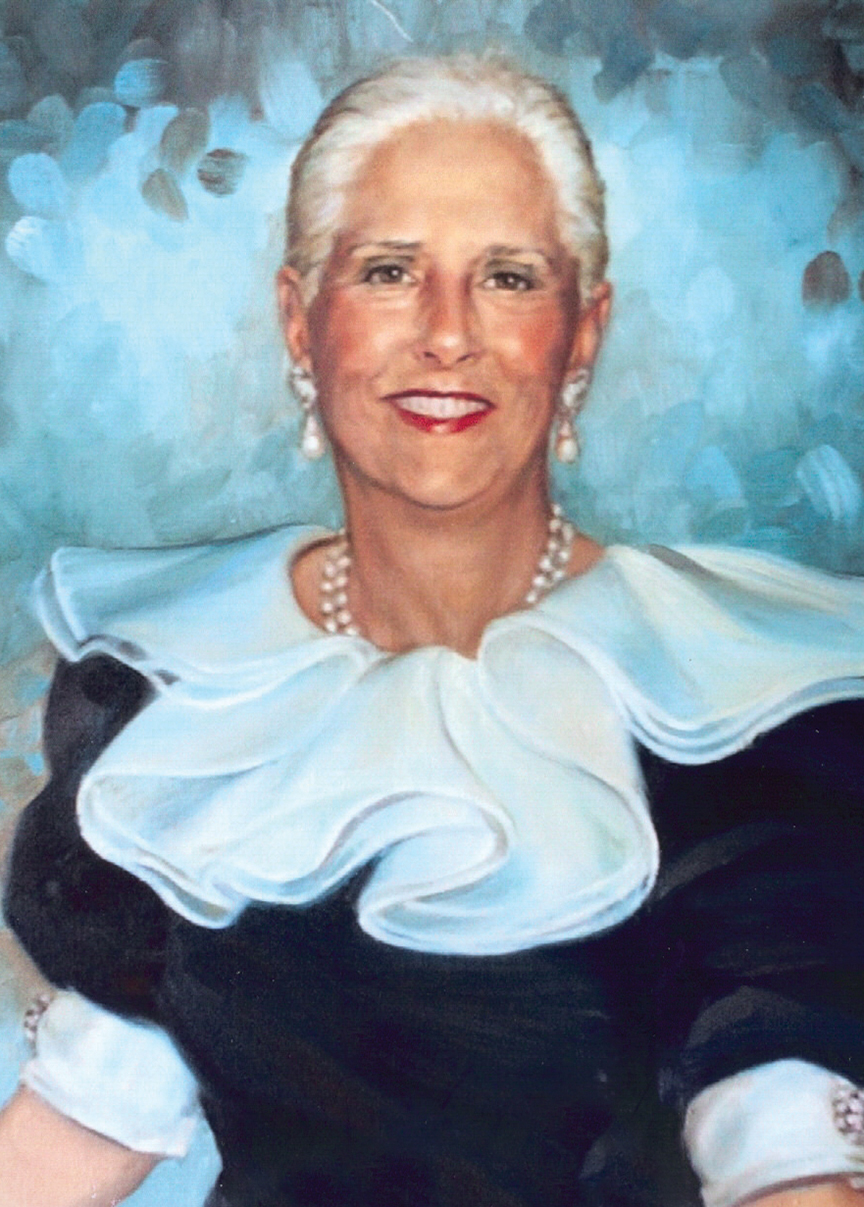
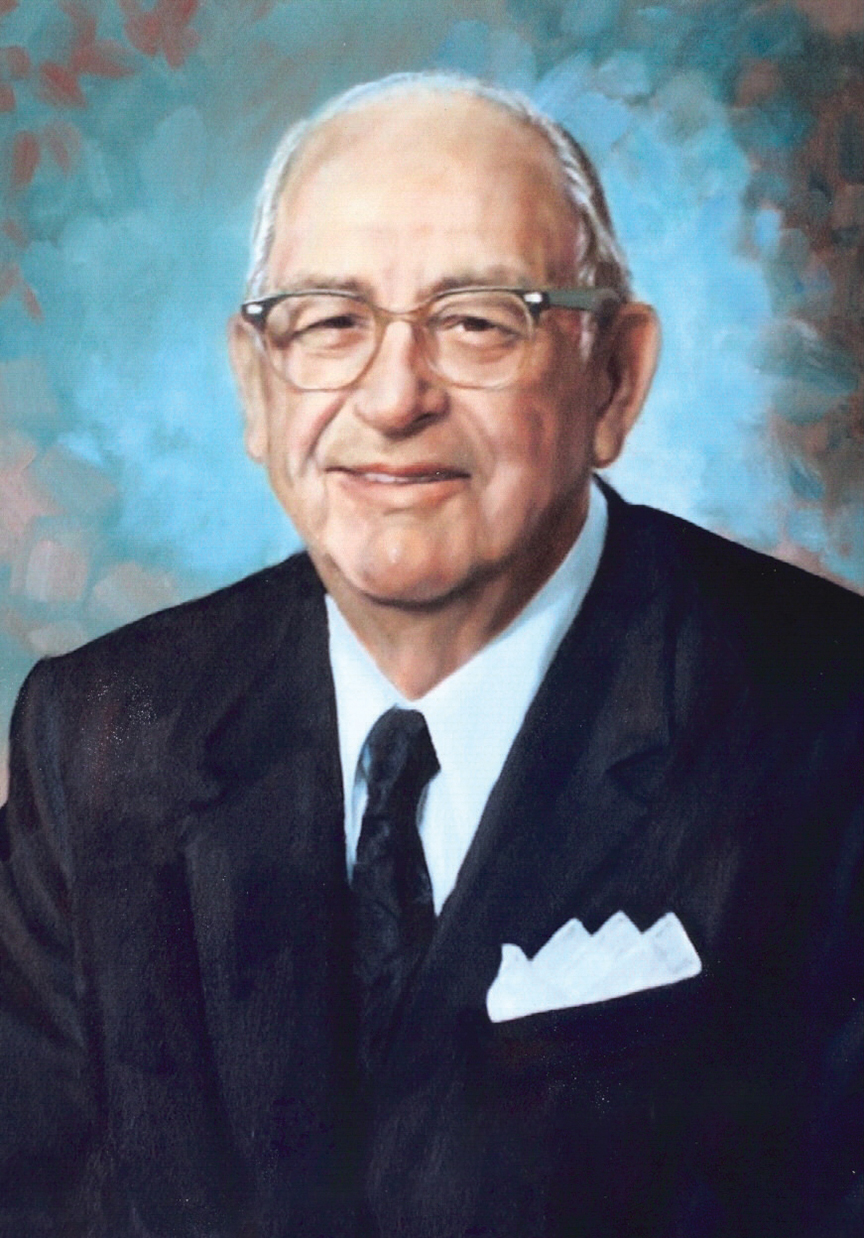
Joan Edwards (1918-2006), born Joan Cavill in London, became a professional singer. She was performing one night at Pittsburgh’s William Penn Hotel when she caught the eye of a young man from Huntington who was working at a division of his father’s company — the National Mattress Company (Namaco). His name was James “Jimmy” Edwards (1910-1991), and he asked to meet her backstage. The two soon were married. Jimmy’s father then summoned the newlyweds to Huntington to live. Jimmy Edwards had always loved horses. Over the years, that love became a virtual obsession. He progressed from buying racehorses to buying racetracks. At one point, he owned 250 horses and four racetracks. He died in 1991 at age 81. Shortly after Jimmy’s death, his wife of 54 years announced that as part of his will, she was presenting $1 million to the Marshall University School of Medicine, $1 million to the Huntington Museum of Art, $2 million to the West Virginia Diocese of the Episcopal Church and $16 million to Cabell Huntington Hospital for construction of an adult cancer center. And that was just the start. Joan Edwards not only carried out the generous bequests spelled out in her husband’s will, she ultimately donated millions more of her own money to Marshall and numerous other worthwhile causes.
Dr. Mildred Mitchell-Bateman
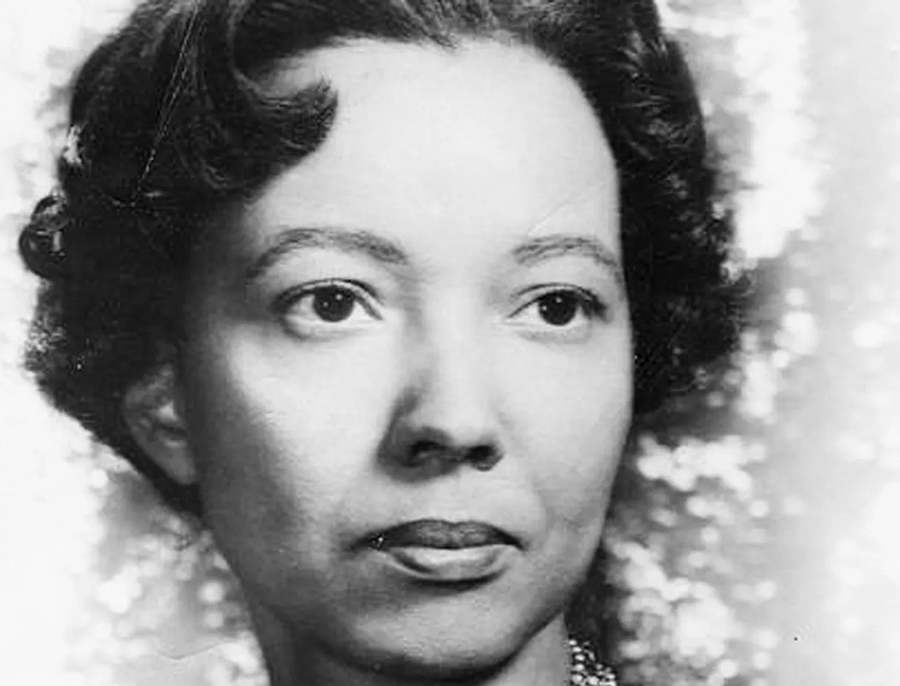
Dr. Mildred Mitchell-Bateman (1922-2012) made history in 1962 when she was named director of the West Virginia Department of Mental Health, making her the first African American woman to lead a West Virginia state agency. Born in Georgia, she came to West Virginia to work as a physician at Lakin State Hospital. After attending the Menninger School of Psychiatry in Topeka, Kansas, she returned to Lakin as the hospital’s clinical director in 1955 and instituted a number of reforms in patient care. After she left her state post, she chaired the Department of Psychiatry at the Marshall University School of Medicine. From 1996 to 2000, she was clinical director at the Huntington State Hospital, which in 1999 was renamed Mildred Mitchell-Bateman Hospital in her honor.
Robert & Roberta Emerson


Long active in local and state politics, Robert K. Emerson, who died in 1991 at age 69, served on John F. Kennedy’s campaign staff during West Virginia’s historic 1960 presidential primary. A native of San Francisco, he grew up in Illinois and served in the Navy in the South Pacific during World War II. He graduated from the University of Virginia Law School in 1949 and became a partner in the Huntington law firm now known as Campbell Woods PLLC. Active in civic affairs, he served on the boards of United Way, the Boy Scouts and the Huntington Museum of Art, where his wife Roberta S. Emerson (1922-1998) was director. In her 16 years as director, Roberta was instrumental in transforming the Huntington Galleries into the Huntington Museum of Art, a transition that meant far more than a change in name. Under her leadership, the museum grew from a staff of five and an annual budget of $125,000 to a staff of 30 and a budget of $1.25 million. She first became involved with the museum as a trustee, was named director in 1972 and held that post until her retirement in 1988.
William C. Campbell
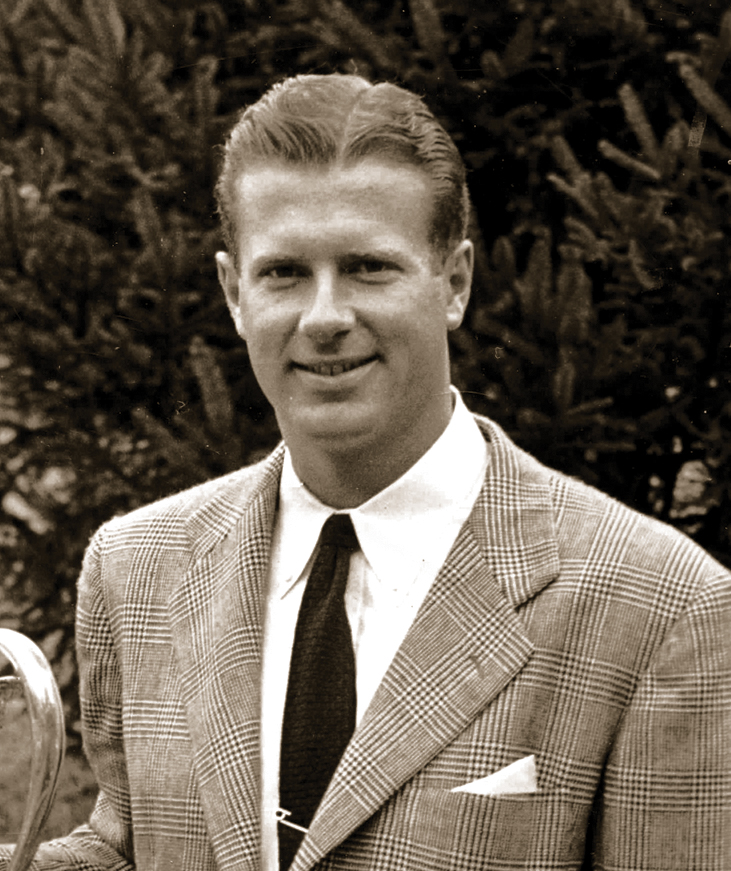
Bill Campbell (1923-2013), as he was known to friends, is regarded as one of the greatest amateur golfers in the history of the game. During his career he won 33 championships, including 15 West Virginia State Amateur titles, three West Virginia Opens, four North-South Amateur Championships, one Mexican National Amateur Championship, two World Amateur Championships and back-to-back U.S. Senior Amateur titles. But his crowning achievement was winning the U.S. Amateur Championship in 1964. He made numerous contributions to the game including serving as president of the USGA and captain of the Royal and Ancient Golf Club in St. Andrews, Scotland. In 1990, he was inducted into the World Golf Hall of Fame. Beyond golf, people in Huntington viewed Campbell as the consummate gentleman. He was a successful businessman who served on dozens of local boards, was active in politics and lent his time to any endeavor that would help better the state he loved so dearly. “Huntington has been a wonderful hometown for me,” Campbell said in a 1990 interview for this magazine. “I have traveled a lot and yet keep coming back. People here care about each other and they take the time to let you know about it.”
Hershel “Woody” Williams

When the Japanese attacked Pearl Harbor on Dec. 7, 1941, Hershel Woodrow Williams (1923-2022), a young farm boy, tried to enlist in the U.S. Marine Corps. No way, the Marines said. All recruits had to be at least 5 feet, 8 inches tall. He was 2 inches too short. But he didn’t give up. He just waited. In 1943, the Marine Corps, badly in need of recruits, did away with its height requirement. Soon Williams — known to family and friends as “Woody” — was part of the huge invasion force that stormed the Japanese stronghold of Iwo Jima. That day saw an officer ask for a volunteer to try taking out the Japanese pillboxes that had his men pinned down. Strapping on a flamethrower, Williams crawled toward the pillboxes. Once he was close enough, he pulled the trigger and a ball of flame raced across the ground and into the gun port of the pillbox, incinerating the Japanese inside. Williams took out seven pillboxes that day — an incredible feat that soon would have him standing at attention in the White House Rose Garden as President Truman presented him the Congressional Medal of Honor, the nation’s highest military decoration.
Ruth C. Sullivan
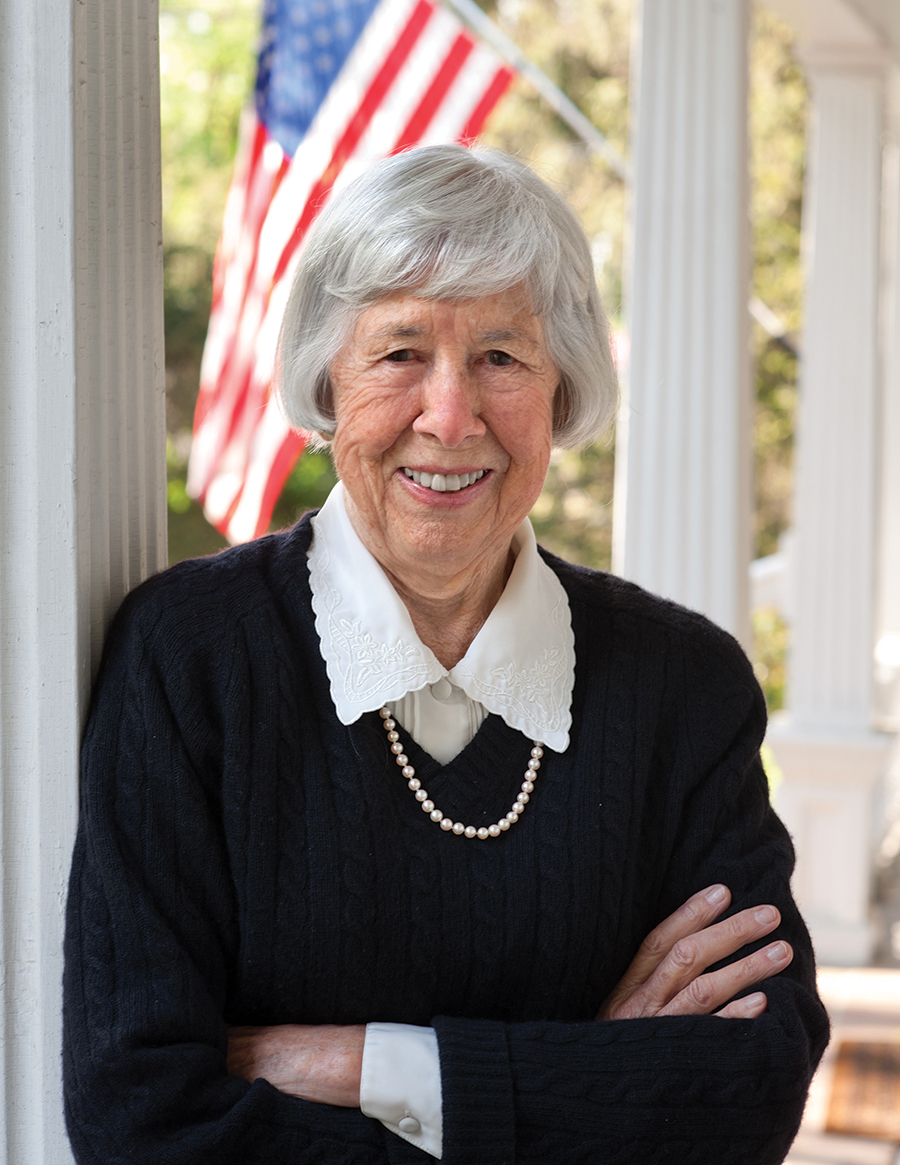
Ruth Christ Sullivan (1924-2021) is recognized worldwide as a pioneer in the field of autism. She and her husband, William Sullivan, had seven children. In 1962, they realized their fifth child, Joseph, was not a normal little boy. In 1963, he was diagnosed with classical autism. At that point, Sullivan began to research, network and organize. In 1965, she co-founded the National Society for Autistic Children, now known as the Autism Society of America. In 1968, the family moved to Huntington, where she started an Information and Referral Service to answer the queries she was receiving from around the world. In 1979, she founded the Autism Services Center (ASC), an agency in Huntington that grew to provide services to thousands of people with autism and developmental disabilities in West Virginia. In 1984, she successfully lobbied the West Virginia Legislature for funding to start the West Virginia Autism Training Center at Marshall University. By the time she retired at age 83, she had received dozens of awards and had been invited to speak around the world.
Art & Joan Weisberg
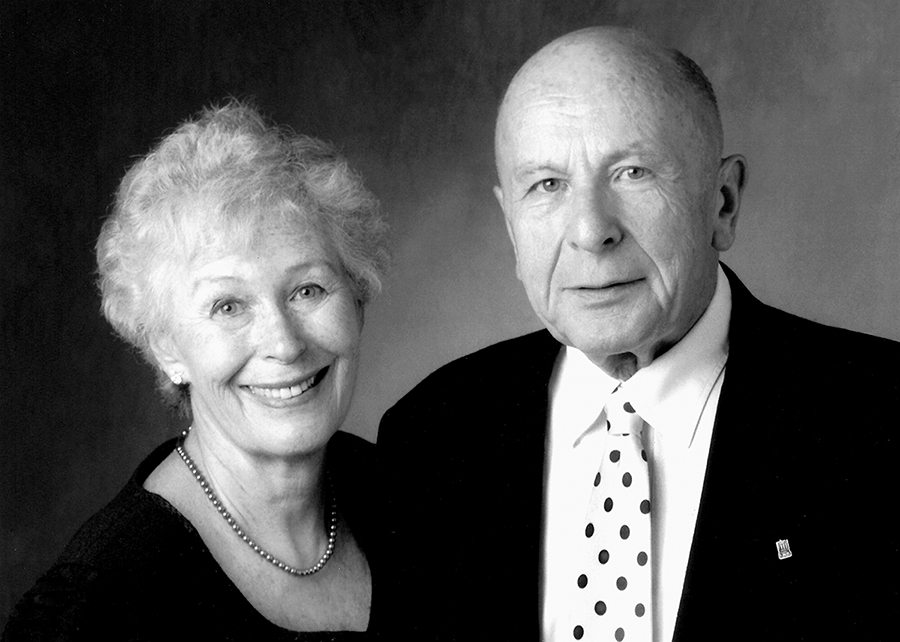
Born in Brooklyn in 1924, Art Weisberg (1924-2012) made his way to West Virginia after serving in World War II and earning a degree in electrical engineering from the City University of New York. In 1952, with a bankroll of $2,500, he started a one-man electrical supply business, calling on small grocery and hardware stores and selling light bulbs, extension cords and fuses from the back of his truck. From that humble beginning, Huntington-based State Electric has evolved into one of the nation’s biggest and best-known electrical distributors, with more than 50 locations in a half-dozen states. Noted for their charitable giving, he and his wife Joan have donated millions of dollars to Marshall University and other recipients in the Huntington region.
Dr. Robert B. Hayes

The Marshall University career of Dr. Robert B. Hayes (1925-2018) spanned nearly 50 years and a long list of posts, including the school’s presidency. A native of Clarksburg, he earned degrees from Asbury College and the University of Kansas following service in the U.S. Marine Corps during World War II. In 1965 he was named dean of MU’s College of Education, a post he held until becoming university president in 1974. His nine years as president saw MU establish a medical school and erect two new classroom buildings, a basketball arena and a major addition to the Science Building. After his tenure as president, Dr. Hayes served as a professor until 1991. After that, he held several interim posts until he officially retired in 2013 at the age of 87.
Nancy Francis
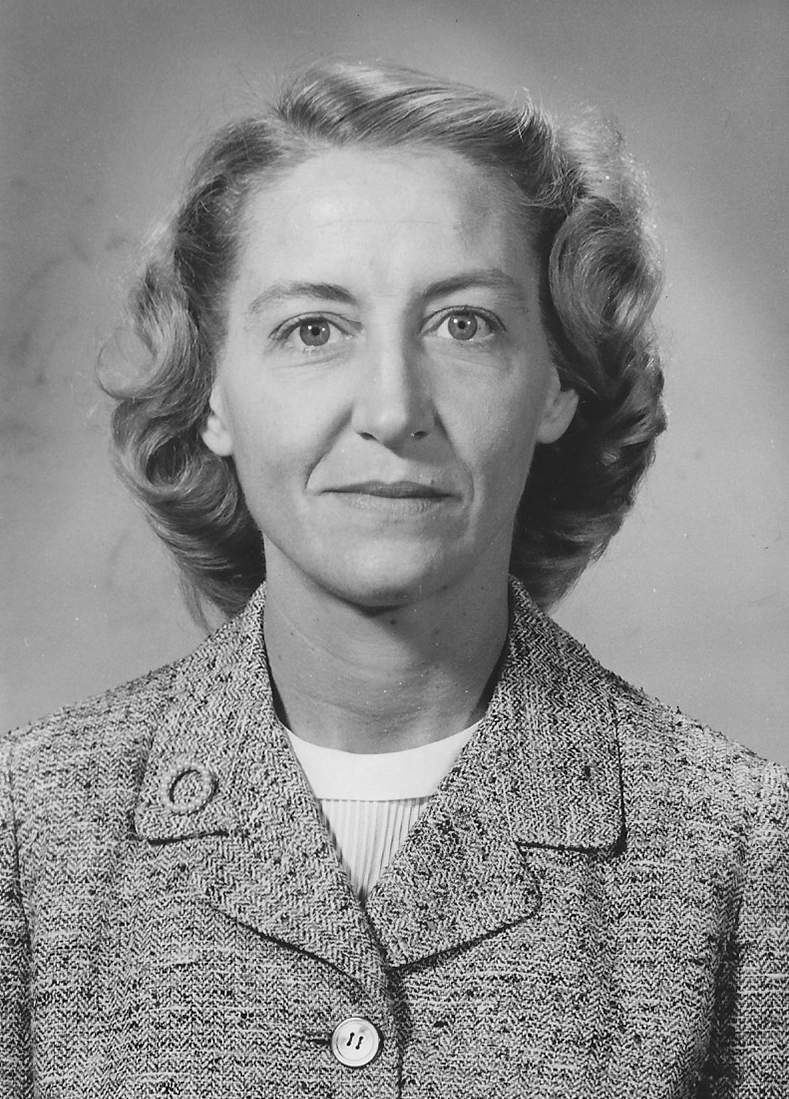
“If you have time, you should give it.” Those simple words by Nancy Francis (1925-2009) summed up her life. In her 84 years she gave of both time and money which positively impacted thousands of lives throughout Huntington. “Volunteering was her life,” said Kheng McGuire, former director of United Way of the River Cities, where Francis served as board president and campaign volunteer. “She rolled up her sleeves and did whatever needed to be done. She was a classy lady with a heart of gold.” Just some of the other organizations she helped included the Huntington Museum of Art, Cammack Children’s Center, The Marshall Foundation, The Society of Yeager Scholars, the Huntington Junior League and Hospice of Huntington. For her countless contributions, she was placed on the Greater Huntington Wall of Fame in 1991 and named the Herald-Dispatch Citizen of the Year in 1992. Following her death in 2009, her daughter Anna Francis noted, “She devoted her life to community service, to making people’s lives better. You give because it’s the right thing to do. You give from your heart.”
Soupy Sales

Soupy Sales (1926-2009), easily Huntington’s most famous resident, rose to stardom with his wild antics, popular TV and radio shows, books and movie appearances. Sales got his start as a journalism student at Marshall College studying under the legendary W. Page Pitt. After graduating from Marshall in 1949, Sales took his talents to Cincinnati, Detroit and eventually New York and Los Angeles. He became famous nationwide for his slapstick comedy, improvisation, zany characters and, of course, throwing pies in the faces of celebrities. Despite his phenomenal success, Sales never forgot his roots. Whether it was on talk shows or appearances across the country, he always spoke glowingly of his hometown. Some say he was the greatest “goodwill ambassador” the city has ever known. “I have strong emotional ties to this town,” he said in a 1995 interview for this magazine. “I love it here. It doesn’t make any difference where I am or what I’m doing, when I think of home,
I think of Huntington. It’s where I spent the happiest years of my life. And I wake up sometimes and I just know I’ve got to come back.”
Dr. Darrel & Laura Darby

Dr. Darrel Darby (1928-2003) practiced podiatry in Huntington for decades. A member of the Trinity Church of God in Huntington, he aided a long list of causes and organizations, from the Huntington City Mission to Marshall University. Frustrated with the design and performance of post-surgical shoes, he designed a new shoe and founded DARCO International Inc. to manufacture and sell them. The Huntington-based company has grown to be a world leader in foot care. Hospice of Huntington began in 1978 when 49-year-old Laura Darby, wife of Dr. Darby, returned to Marshall University to fulfill her dream of becoming a nurse. In her final semester she envisioned a hospice program that would provide end-of-life care for patients. Seeking help to make that dream a reality, she was repeatedly told “no.” Undismayed, she kept asking. Today, Hospice of Huntington has a multimillion-dollar budget and a modern facility, and over the years it’s cared for thousands of patients.
Hal Greer

A standout high school player for Douglass High School in Huntington, Hal Greer (1936-2018) made history when he became the first African American to break the color line in West Virginia when he signed to play basketball at Marshall University. Greer went on to play in the NBA for the Philadelphia 76ers, where he had a highly decorated career including an NBA Championship. He was a 10-time NBA All-Star and in 1996 was named one of the 50 Greatest Players in NBA History. Huntington honored the basketball icon by renaming 16th Street “Hal Greer Boulevard” in 1978. In 2021, Marshall University further honored the basketball great by erecting a stunning 8-foot bronze statue of his likeness that stands proudly in front of the Cam Henderson Center.
A. Michael Perry
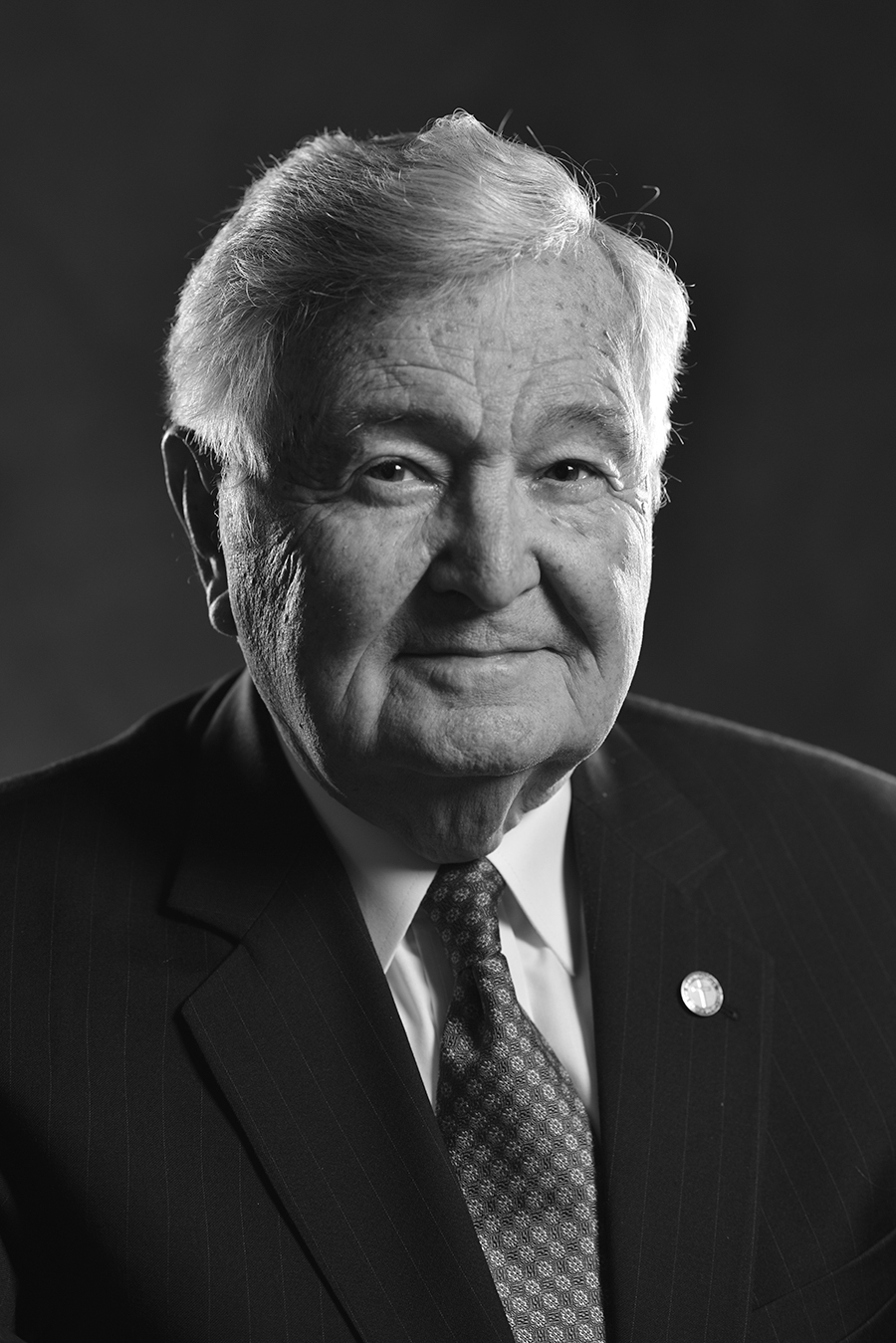
Lawyer, banker, university president, museum founder. These are just some of the roles Huntington native Mike Perry (1936-2015) filled during his life. What’s more, Perry played a pivotal role in nearly every progressive stride Huntington made over the past 30 years. After beginning his career as a lawyer, he was recruited by businessman Marshall Reynolds to run First Huntington National Bank in 1981. Perry and Reynolds then formed Key Centurion Bancshares and began acquiring banks across West Virginia. Eventually the holding company was sold to Bank One which made millions of dollars for numerous investors in Huntington. In 1999, Perry was tapped to serve as interim president of Marshall University. In his spare time, he and his wife Henriella began fulfilling their dream of building a history museum on their Wayne County farm. Over the course of several years they acquired old cabins, barns and other structures which morphed into what is now Heritage Farm Museum & Village. Today, there are 30 buildings at the village including museums of progress, transportation, industry and heritage. There’s a country store, blacksmith shop, sawmill, pottery kiln, one-room schoolhouse, chapel and more. The goal of the museum is to teach future generations about their ancestors who settled in West Virginia. As Perry said, “If we apply the same lessons that our ancestors taught us — being willing to embrace change, foster change, adapt to change — then we can also make the world a better place.”
Marshall Reynolds
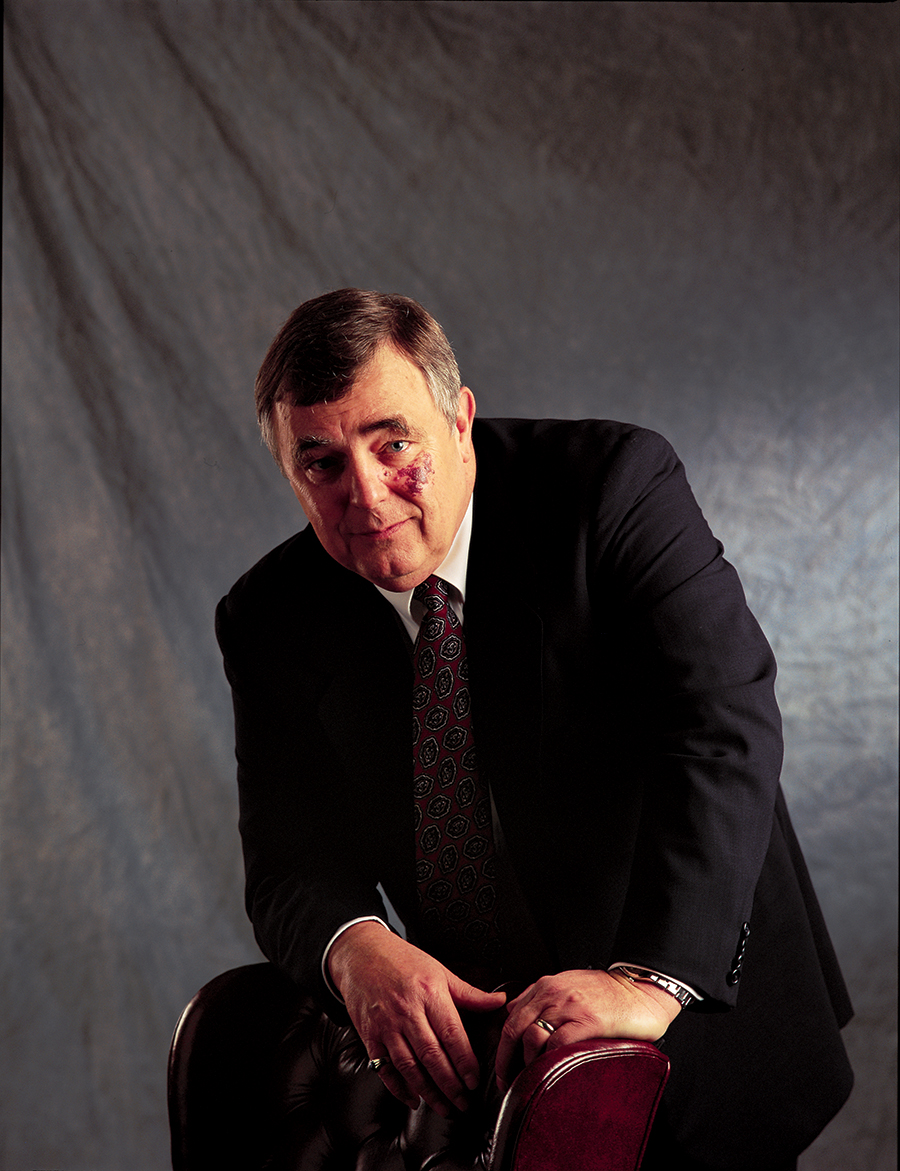
Marshall Reynolds, widely considered the most accomplished entrepreneur in the history of Huntington, began his career as a “clean-up boy” for Chapman Printing in the late 1950s. He worked his way up to delivery boy, then salesman, and in 1964 he bought the company from his former boss. He would go on to acquire or open printing plants in eight states throughout the Southeast. Today his business empire also includes interests in banking, manufacturing, real estate and media in some 15 states and 33 cities across the country. Beyond his financial successes he has been generous with both his time and money. He has taught Junior Achievement classes, coached high school basketball, endowed scholarships at Marshall University, advocated for economic development and served on dozens of charitable boards. It is said that no one has raised more money for the Boys & Girls Clubs and the United Way than Marshall Reynolds. Finally, many local business owners owe their start to Reynolds, who counseled and encouraged them to follow their entrepreneurial dreams.
Robert L. Shell Jr.
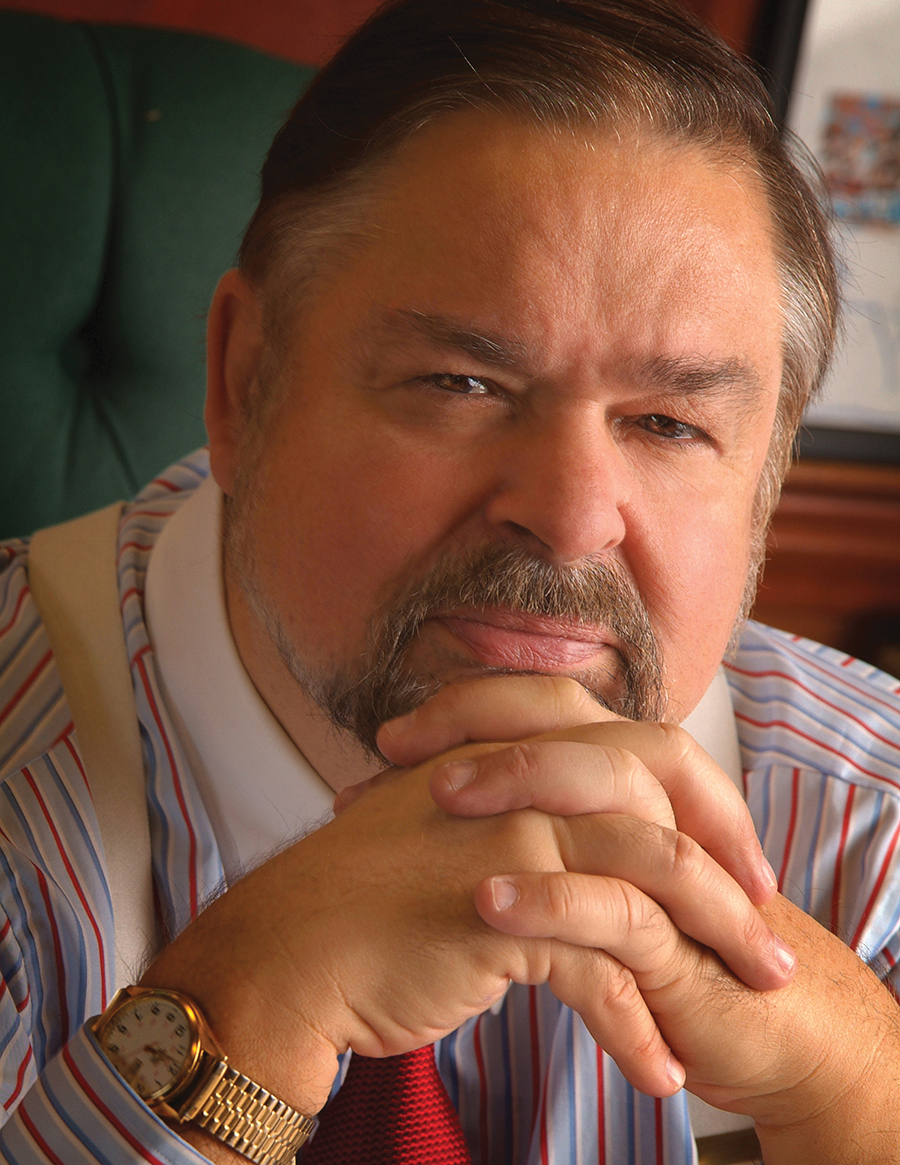
Born in Logan, West Virginia, in 1943, Bob Shell entered his family’s manufacturing businesses — Guyan Machinery and Permco — in 1968. He quickly grew the hydraulic pump operations into a thriving international success that today stretches from the United States to China. In 1989 he moved the company’s corporate headquarters to Huntington and became active in the community. He has served on numerous boards including stints as chairman of the Marshall University Board of Governors and the Marshall Artists Series. He has been a generous donor to more than 100 charities including Marshall University, St. Mary’s Medical Center, United Way, local law enforcement and various children’s causes. He has been honored numerous times, including induction into the Huntington Wall of Fame, MU Business Hall of Fame and WVU Business Hall of Fame. As Shell once said, “The best thing about making money is it gives you the ability to make a difference in the lives of others.”
Dr. Joseph B. Touma

Dr. Joseph B. Touma is known nationally for his medical expertise in otolaryngology. But in Huntington he’s equally well known for buying and painstakingly restoring a number of downtown retail buildings. While many individuals have refurbished Huntington’s aging structures over the years, perhaps no one has done more than Touma. He almost single-handedly revamped the south side of Third Avenue in downtown Huntington. He also founded the Touma Medical Museum — a unique collection of antique medical artifacts. He and his wife, Dr. Omayma Touma, have presented the Huntington Museum of Art with numerous gifts and art from their home country of Syria, many of which are housed in the museum’s Touma Near Eastern Gallery.
Jan Rader

Jan Rader first rose to prominence in Huntington in 2017 when she became West Virginia’s first professional female fire chief. That same year she was featured in the Oscar-nominated Netflix documentary Heroin(e) which highlighted efforts to battle the opioid crisis in Huntington. In 2018, she was recognized for her relentless and innovative work combating the opioid epidemic in West Virginia when she was named to the TIME 100 — a list of the 100 most influential people in the world. In the TIME magazine article written by West Virginia Sen. Joe Manchin, he described Rader as a true hero: “She has saved countless lives and has been unrelenting in her commitment to help people struggling with substance-use disorders return to lead productive lives. If every city had a chief like Jan Rader, our country would be a better place.”
Brad D. Smith
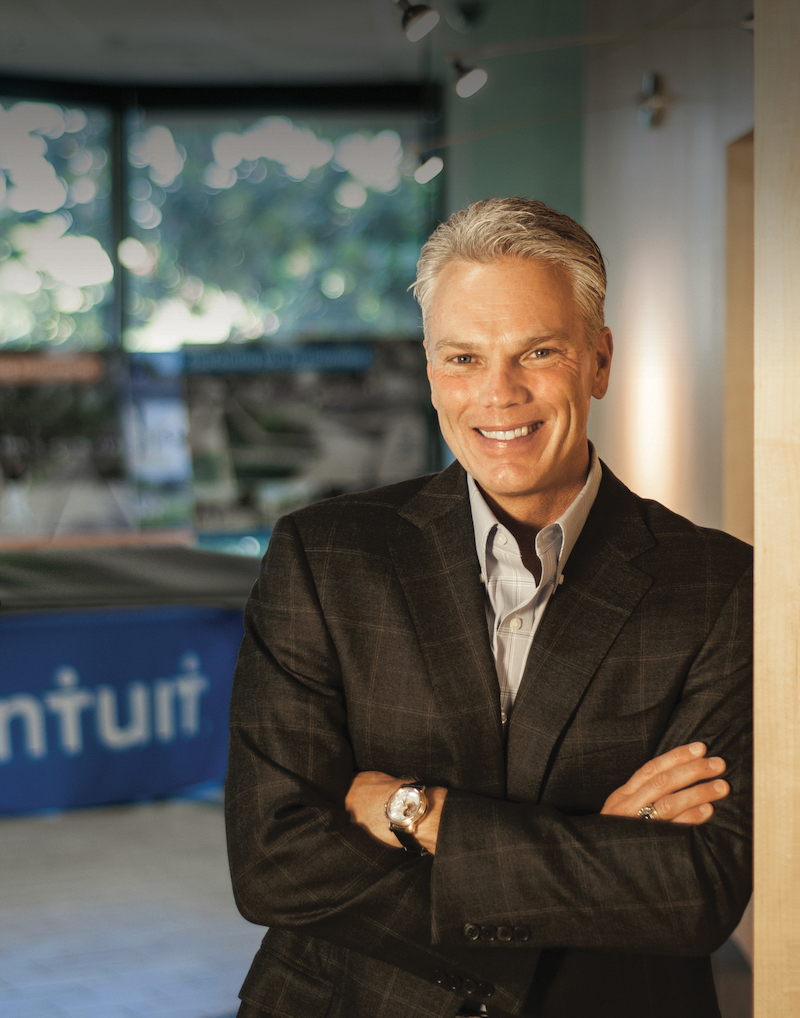
The Kenova native and Marshall University alumnus first rose to national prominence in 2008 when, at age 43, he was named CEO of software giant Intuit in Silicon Valley. Smith’s decade-long tenure at the helm saw phenomenal growth at the company and earned him numerous accolades. In 2017, Fortune ranked him No. 6 on its list of Top CEOs in the United States, while Forbes named him one of the Top 10 Influential American Business Leaders. After retiring in 2018, he and his wife Alys started a philanthropic foundation to ensure that the people of Appalachia are no longer overlooked and are given every chance to succeed. To date their foundation has donated more than $60 million to worthwhile projects in West Virginia alone. On Oct. 28, 2021, Smith fulfilled a longtime dream of returning to Huntington when he was named the 38th president of Marshall University. “When I stepped down as CEO of Intuit, it became clear what my purpose was — to return to West Virginia and make a difference,” Smith said. “Anything I have accomplished in life is because someone at Marshall University invested in me. I consider it the ultimate privilege to be able to pay that privilege forward to the next generation.”

